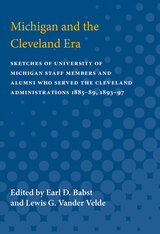 Michigan and the Cleveland Era: Sketches of University of Michigan Staff Members and Alumni Who Served the Cleveland Administrations 1885-89, 1893-97
Edited by Earl D. Babst and Lewis G. Vander Velde
University of Michigan Press, 1948 This is a four-year labor of love by a group of alumni of the University of Michigan. It depicts the contribution by the University to the public life of the country at a turning point in our national history.Our country has for more than three hundred years been engaged in developing an educational system, culminating in the colleges and universities, public and private. The success of such a program is properly measured by the degree to which it contributes enlightened leadership to the communities, large and small, which provide its support.The present volume shows how one institution, at one period in American history, provided from among its graduates and faculty members a generous measure of leadership in a variety of important public functions. The collected result provides further evidence that American higher education justifies by its output the effort that has gone into its establishment and continued support.
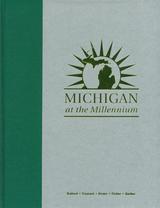 Michigan at the Millennium: A Benchmark and Analysis of Its Fiscal and Economic Structure
Charles L. Ballard
Michigan State University Press, 2003
Michigan at the Millennium provides objective background and analysis on a wide variety of key economic and fiscal issues. The chapters are written by economists and policy analysts at leading universities and other institutions in Michigan. Written in clear, non-technical language, the articles are aimed at an audience that includes members of the legislative and executive branches of state government, members of the judicial system, local government officials, policy analysts, and informed citizens.
This volume follows in the tradition of the landmark 1982 study, Michigan’s Fiscal and Economic Structure, edited by Harvey E. Brazer. The first section of the volume focuses on broad aspects of the economy, people, and land of Michigan, including chapters on demographics, the labor force, land use, the manufacturing sector, high-technology industries, and health care. Section two focuses on public expenditures and public services, and includes chapters on economic-development efforts, K–12 education, the transportation system, the welfare system, policies for low-wage workers and displaced workers, and pensions. The third section is concerned with taxes and other government revenues. It includes chapters on the Headlee Amendment, income taxes, sales and use taxes, property taxes, the Single Business Tax, intergovernmental fiscal relations, and other sources of revenue.
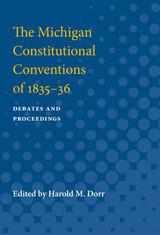 The Michigan Constitutional Conventions of 1835-36: Debates and Proceedings
Edited by Harold M. Dorr
University of Michigan Press, 1940 In the years immediately preceding 1837, when Michigan was at last admitted to the Union, her constitution and State Government were devised by her pioneer inhabitants. The formal proceedings of the Constitutional Conventions of 1835–36 were printed at the time but are now extremely rare volumes. The debates in the Constitutional Conventions were never officially printed, but author Harold M. Dorr has been able to extract many of them from contemporary newspapers and has combined them with the official records in such a way as to present the complete story of how one American state faced and solved the problem of its own organization. Thus, the volume contains materials that the historical student could not gather for himself except at the expenditure of much time and trouble. Dorr is an Assistant Professor of Political Science at the University of Michigan.
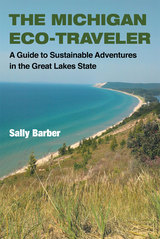 The Michigan Eco-Traveler: A Guide to Sustainable Adventures in the Great Lakes State
Sally Barber
University of Michigan Press, 2014 Michigan offers some of the most wonderfully diverse recreation opportunities in the country. The Michigan Eco-Traveleris for a new and growing breed of leisure traveler and adventurer—the individual seeking to experience the pleasant peninsulas responsibly by minimizing his or her eco-footprint. The book introduces readers to the importance of eco-friendly travel and highlights some of the best eco-conscience venues across the state that offer activities from golfing to skiing to sailing and much more. The book also examines environmental pressures on the state’s recreational resources, revealing the critical need for joining together in conservation practices, and offers travelers helpful tips for evaluating the sustainability of their own favorite recreational spots. Whether you’re a weekend traveler, extreme adventurer, or family on vacation, The Michigan Eco-Travelerlights the way to a greener getaway. Naturalists, conservationists, and hospitality experts will find the book equally helpful in responding to the ever rising demand for sustainable recreation.
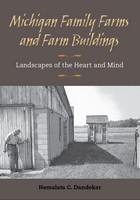 Michigan Family Farms and Farm Buildings: Landscapes of the Heart and Mind
Hemalata Dandekar
University of Michigan Press, 2010 Michigan's family farms form the backbone of the state. One need only see the Centennial Farm signs that dot the sides of the state's country roads to understand that. Hemalata Dandekar shows in her new book just how connected those family farm buildings are to the families that inhabit them. Eight family-farm case studies display farm buildings' relationship to the land they sit on, their function on the farm, the materials they're made with, the farm enterprises themselves, and the families who own them. Photographs, plans, elevations, and sections of typical, exemplary traditional farm buildings show the aesthetic and architectural qualities of those types of buildings across the state. The ways in which the buildings serve the productive activities of the farm, shelter and nourish the people and livestock, yield a living, and enable the aspirations of farm people are shown in the words and photographs of the farmers themselves. The buildings form a window into the lives of Michigan's family farms and into the hearts and minds of the people who have lived and worked in them their entire lives.
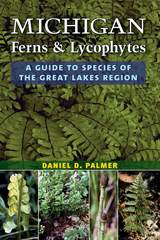 Michigan Ferns and Lycophytes: A Guide to Species of the Great Lakes Region
Daniel D. Palmer
University of Michigan Press, 2018 Michigan’s ferns and lycophytes are among the state’s most fascinating plants. The species in these groups exhibit incredibly diverse life cycles and an amazing array of morphology. Some species such as the Bracken fern are widespread and aggressive, dominating forest understories throughout much of northern Michigan, while other species are exceedingly rare and adapted to life solely in harsh niche habitats where little else can grow.
Unlike the well-studied flowering plants and gymnosperms, Michigan’s ferns and lycophytes have long lacked a reliable, up-to-date guidebook, and this book fills that gap. Covering all 120 taxa found in the state, it features detailed keys, species descriptions, and range maps alongside precise illustrations. Readers learn about the etymology of species’ common and scientific names as well as interesting facts about their historic uses by humans and place within the Michigan ecosystem. The book also provides information on the challenging taxonomy of many ferns and lycophytes, with special attention given to the species likely to hybridize and those prone to misidentification. This is a must-have reference for anyone who wishes to learn about these important components of the Great Lakes flora.
Michigan Free: Your Comprehensive Guide to Free Travel, Recreation, and Entertainment Opportunities
Eric Freedman
University of Michigan Press, 1993 Whether your preference is for indoor or outdoor activities, whether you live in-state or are just planning to visit, whether you are traveling with children, as a couple, or singly, Michigan Free lists an abundance of cost-free or inexpensive activities from Detroit to the remote reaches of the Upper Peninsula, for all seasons. Michigan Free provides detailed information about free or inexpensive concerts, plays, museums, wildlife preserves, national parks and forests, live theater and dance, musical performances, nature centers, festivals, walking tours, and more. Also provided is an in-depth look at a variety of free attractions such as the annual Labor Day walk across the Mackinac Bridge. Each listing includes a description of the attraction, its location, and its hours of operation.
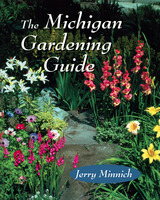 The Michigan Gardening Guide
Jerry Minnich
University of Michigan Press, 1998 It's all here---step-by-step guidance for gardening success in Michigan's varying soil types and often difficult climate. Veteran garden writer Jerry Minnich presents detailed directions and practical tips for growing vegetables, herbs, flowers, landscaping plants, and house plants, as well as dependable advice on hundreds of garden operations. Minnich begins where gardening begins---in the soil---as he tells how to build a healthy and productive soil, and how to solve soil problems. In subsequent chapters he reveals composting and mulching techniques, and what to do when the weather is less than congenial for gardens. Minnich describes more than sixty Michigan vegetables, tells how to grow them, and lists recommended varieties for each. There are also chapters on growing fruits, berries, and nuts, and on food storage. Minnich devotes a chapter to growing annuals and perennials, another on lawns, trees, and ornamental woody plants. He tells how to deal with insect and animal pests without using harmful chemicals, and he includes a major section on houseplants. Throughout, Minnich approaches the subject with experience, wit, and style. Readers will learn how to deal with weeds in the lawn, how to surf the landscape for com-posting materials, and how to grow mulch at home. He explains intercropping, companion planting, seed saving, cover cropping, strip composting and other techniques. He tells how to raise unusual crops such as tomatillos and radicchio, as well as the standard favorites. He explains how the science of phenology can help the gardener, how to take a soil test, how to use earthworms to turn household wastes in to compost, and how to attract birds and toads to the garden. And he lists more than a thousand varieties of vegetables, herbs, fruits, and ornamentals that can be trusted to grow in the Michigan climate. The Michigan Gardening Guide is the one backyard guide that Michigan gardeners can trust. It is a tool as indispensable as the hoe and the shovel. Jerry Minnich has written about gardening for more than twenty years and has been commended with a Certificate of Merit by the Garden Writers Association of America. His interest in gardening began when he joined the staff of Organic Gardening in the 1950s.
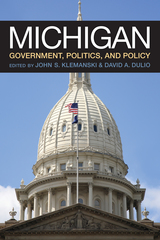 Michigan Government, Politics, and Policy
John S. Klemanski and David A. Dulio, editors
University of Michigan Press, 2017 The State of Michigan has experienced both tremendous growth and great decline in its history. After many decades of growth up to the 1950s, a wide variety of challenges had to be confronted by citizens and all levels of government in Michigan. The late 20th and early 21st centuries have seen pockets of growth but also long-term economic decline in several areas in the state. As one example, steep economic decline in major industrialized cities such as Detroit, Flint, and Pontiac led to increased unemployment rates and flight from the state as residents sought jobs elsewhere. Michigan was in fact the only state in the union to experience net population loss between 2000 and 2010. At the same time, emergencies such as the Detroit bankruptcy and the Flint water crisis have captured the attention of the national and international media, focusing the spotlight on the responses—successful or unsuccessful—by state and local government.
As the state continues to deal with many of these challenges, Michiganders more than ever need a clear picture of how their state’s political institutions, actors, and processes work. To that end, this book provides a comprehensive analysis of Michigan’s politics and government that will help readers better understand the state’s history and its future prospects. Chapters elucidate the foundational aspects of the state’s government (the Michigan Constitution and intergovernmental relations); its political institutions (the state legislature, governor, and court system); its politics (political parties and elections); and its public policy (education, economic development, and budget and fiscal policy). The book’s four themes—historical context, decline, responses to challenges, and state-local government relations—run throughout and are buttressed by coverage of recent events. Moreover, they are brought together in a compelling chapter with a particular focus on the Flint water crisis.
An ideal fit for courses on state and local government, this thorough, well-written text will also appeal to readers simply interested in learning more about the inner workings of government in the Great Lakes State.
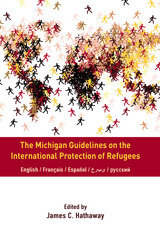 The Michigan Guidelines on the International Protection of Refugees
James C. Hathaway
Michigan Publishing, 2019 The Michigan Guidelines on the International Protection of Refugees are the result of a collective endeavor of hundreds of scholars, advocates, judges, and international officials to tackle some of the most important and challenging questions in international refugee law. This volume presents 20 years of the Guidelines — the consensus work of senior Michigan Law students and experts from around the world on cutting-edge refugee law concerns — in five languages (English, French, Spanish, Arabic, and Russian).
The Guidelines address five of the most difficult issues of refugee status: what is the meaning of a “well-founded fear”; when may refugee status be denied on grounds of an “internal protection alternative”; how is the causal connection to a Convention ground to be assessed; when is a risk fairly said to be for reasons of “political opinion”; and under what circumstances are persons believed to have violated rules of international criminal law to be excluded from refugee status? Additionally, this volume also addresses three critical aspects of refugee rights – when may a refugee be required to seek protection in a country not of his or her choosing; to what extent is a refugee entitled to undertake employment or other economic activity; and what is the scope of a refugee’s right to freedom of movement, both between states and within the asylum country?
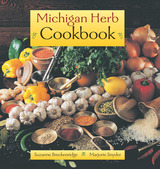 Michigan Herb Cookbook
Suzanne Breckenridge and Marjorie Snyder
University of Michigan Press, 2001 If you're interested in cooking with herbs and want to use the best of Michigan and the Midwest's seasonal foods, then this is the cookbook for you. The recipe section is written for both the novice and the more experienced cook. Each recipe has helpful information about serving suggestions and menu ideas. Scattered throughout the book are handy tips related to foods, herbs, and cooking. In addition, Michigan Herb Cookbook includes a section on herb growing and designing in which planting, growing, freezing, drying, and storage tips for over thirty herbs are explained in detail. You will find over 150 recipes in the book's seven chapters. More than half are low-fat, and there are many vegetarian favorites. Also, a chapter devoted to condiments and "little extras" contains various herb blend, vinegar, chutney, pesto, and sauce recipes, such as Sun-Dried-Tomato Pesto and Roasted Red Pepper Sage Sauce. Suzanne Breckenridge, formerly a ceramics and cooking instructor, is now a food stylist and caterer. Marjorie Snyder is a freelance food writer, a cooking teacher at a junior college, and cofounder and president of the Madison Wisconsin Herb Society.
Michigan Journal of Community Service Learning: Volume 23 Number 1 - Fall 2016
Jeffrey Howard, editor
Michigan Publishing, 2017 Launched in 1994, the Michigan Journal of Community Service Learning (MJCSL) is an international, peer-reviewed, multi-disciplinary academic journal for college and university faculty and administrators, with an editorial board and cadre of peer reviewers representing faculty from many higher education disciplines and professional fields. It is a publication of the University of Michigan’s Ginsberg Center.
Each issue consists of articles at the cutting edge of research, theory, pedagogy, and other matters related to academic service-learning, campus-community partnerships, and engaged, public scholarship in higher education that extend the knowledge base and support and strengthen researchers’ and practitioners’ work. We also publish review essays of newly-released books pertinent to service-learning and community engagement.
Michigan Journal of Community Service Learning: Volume 23 Number 2 - Spring 2017
Jeffrey Howard, editor
Michigan Publishing, 2017 Launched in 1994, the Michigan Journal of Community Service Learning (MJCSL) is an international, peer-reviewed, multi-disciplinary academic journal for college and university faculty and administrators, with an editorial board and cadre of peer reviewers representing faculty from many higher education disciplines and professional fields. It is a publication of the University of Michigan’s Ginsberg Center.
Each issue consists of articles at the cutting edge of research, theory, pedagogy, and other matters related to academic service-learning, campus-community partnerships, and engaged, public scholarship in higher education that extend the knowledge base and support and strengthen researchers’ and practitioners’ work. We also publish review essays of newly-released books pertinent to service-learning and community engagement.
Michigan Journal of Community Service Learning: Volume 24 Number 1 - Winter 2017
Jeffrey Howard
Michigan Publishing, 2017 Launched in 1994, the Michigan Journal of Community Service Learning (MJCSL) is an international, peer-reviewed, multi-disciplinary academic journal for college and university faculty and administrators, with an editorial board and cadre of peer reviewers representing faculty from many higher education disciplines and professional fields. It is a publication of the University of Michigan’s Ginsberg Center. Each issue consists of articles at the cutting edge of research, theory, pedagogy, and other matters related to academic service-learning, campus-community partnerships, and engaged, public scholarship in higher education that extend the knowledge base and support and strengthen researchers’ and practitioners’ work. We also publish review essays of newly-released books pertinent to service-learning and community engagement.
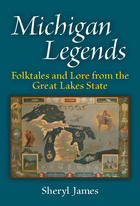 Michigan Legends: Folktales and Lore from the Great Lakes State
Sheryl James
University of Michigan Press, 2013 Over the course of its history, the state of Michigan has produced its share of folktales and lore. Many are familiar with the Ojibwa legend of Sleeping Bear Dunes, and most have heard a yarn or two told of Michigan’s herculean lumberjack, Paul Bunyan. But what about Detroit’s Nain Rouge, the red-eyed imp they say bedeviled the city’s earliest residents? Or Le Griffon, the Great Lakes’ original ghost ship that some believe haunts the waters to this day? Or the Bloodstoppers, Upper Peninsula folk who’ve been known to halt a wound’s bleeding with a simple touch thanks to their magic healing powers? In Michigan Legends, Sheryl James collects these and more stories of the legendary people, events, and places from Michigan’s real and imaginary past. Set in a range of historical time periods and locales as well as featuring a collage of ethnic traditions—including Native American, French, English, African American, and Finnish—these tales are a vivid sample of the state’s rich cultural heritage. This book will appeal to all Michiganders and anyone else interested in good folktales, myths, legends, or lore.
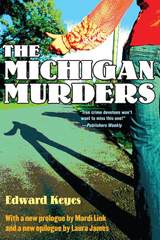 The Michigan Murders
Edward Keyes
University of Michigan Press, 2010 "True crime devotees won't want to miss this one!"
---Publishers Weekly "Very engrossing . . . in the finest you can't put it down tradition."
---Hartford Courant "This factual account of each murder, through the conviction of the killer, has all the excitement of a first-rate work of fiction, and is told straight, without the usual sociological jargon. Keyes collaborated with Robin Moore on The French Connection; The Michigan Murders is his first solo effort, and it is a good one."
---Miami Herald "The Michigan Murders is the ultimate True Crime classic, unfolding like great mystery fiction while still delivering the powerful charge of real life."
---Jamie Agnew, Aunt Agatha's Mystery Bookshop With a new prologue by Mardi Link and a new epilogue by Laura James The true story of the savage coed killings---by the boy who could have lived next door! Southeastern Michigan was rocked in the late 1960s by the terrifying serial murders of young women, whose bodies were dumped in Ann Arbor and Ypsilanti. In each case, few clues were left at the scene, and six separate police agencies were unable to end the horror. Then, almost by accident, a break came. The suspect: John Norman Collins, a young, quiet, all-American boy. Collins was caught, went to trial, and, on August 19, 1970, was found guilty and sentenced to life imprisonment with no possibility of parole. He is now in his sixties and is serving his sentence in Marquette, Michigan. Collins was one of the first serial killers exposed in the region, and his crimes had many in the area locking their doors for the first time. Edward Keyes's harrowing The Michigan Murders covers every step of the case. It fell out of print for more than a decade before being revived for this special edition. Mardi Link, author of the new prologue, is the author of two regionally best-selling true crime books based in northern Michigan, When Evil Came to Good Hart and Isadore's Secret. Laura James, author of the new epilogue, is a trial lawyer, crime historian, and true crime author who blogs about the true crime genre at her Web site CLEWS (www.laurajames.com). Edward Keyes, now deceased, spent several years in the early 1970s investigating the Michigan murders. He also authored the works Double Dare and Cocoanut Grove. The Michigan Murders was a finalist for the Edgar Allan Poe Award for Best Fact Crime in 1977.
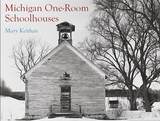 Michigan One-Room Schoolhouses
Mary Keithan
University of Michigan Press, 2008 Nostalgic reminders of a time now past, one-room schoolhouses are deeply embedded in our heritage. Decades after their original purpose and inhabitants have vanished, they dot the rural landscape in all conditions, from neglected and near collapse to handsomely renovated places repurposed into a new existence as living quarters. Today no matter their state they stand as miniature gems of nineteenth-century American history as well as charming examples of rural architecture---above all, things to be treasured and preserved. Mary Keithan's Michigan One-Room Schoolhouses is a beautifully illustrated chronicle that details nearly a hundred of the state's early schoolhouses. Together with information about each schoolhouse's architecture and history, including interviews with former students and teachers, Keithan's photographs bring these structures back to life and assure their place in history. Mary Keithan is a professional photographer living in Ray, Michigan. Her previous books include Michigan's Heritage Barns and A Time in Michigan: A Photographic Series. New York Times critic Vicki Goldberg selected Keithan's 1995 image "Desert Storm Barn" for the Light Impression Biennial.
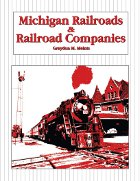 Michigan Railroads & Railroad Companies
Graydon M. Meints
Michigan State University Press, 1992 Michigan Railroads and Railroad Companies is an invaluable reference manual for everyone interested in regional transportation history, the history of railroading, and Michigan history in general. It contains complete, cross-referenced listings for every company formed to operate a railroad in the state of Michigan. In addition to the comprehensive entries for major lines, Graydon Meints has included details about the many small, common-carrier steam and electric companies, logging roads, and numerous other primitive and contemporary rail systems. This encyclopedic reference guide also contains information on the so-called "paper railroads," companies that were projected but which never laid a foot of track.
Michigan Railroads is divided into three parts. One includes alphabetical entries for the actual and intended railroad companies themselves, the date and purpose for their organization, and a brief history from their origins to their dispositions. Included in this portion of the work are a number of railroad "family trees" showing the corporate antecedents of the largest of the rail lines operating in the state today. Another contains a chronology of significant corporate events; it works as a useful finding aid for accessing source data contained in the first section. A third contains a statewide county-by-county listing of railroads, both paper and real.
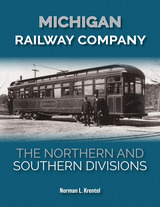 Michigan Railway Company: The Northern and Southern Divisions
Norman L. Krentel
Michigan State University Press, 2024 Michigan Railway Company: The Northern and Southern Divisions, the first comprehensive history of the Michigan United Railway Company, traces the rise and fall of Michigan’s most significant electric railway. This volume covers the company’s founding in local rail-based public transportation systems in Lansing, Jackson, Battle Creek, Kalamazoo, and Owosso-Corunna and ends with its eventual demise, abandoned prior to the stock market crash of 1929. Norman L. Krentel follows the fragments of lines in lower Michigan, which came together to form the MUR. He examines the interurban lines, which were broken down into five divisions, each with a separate superintendent. These divisions were Northern and Southern, which had formerly been Michigan United Railways; Northwestern, which had been Grand Rapids, Holland, and Chicago Railway; Western; and Northeastern.
This also explores how electric railway history is intertwined with the state of Michigan. The interurban electric rail system supported automobile manufacturing, allowing for the shipment of parts supplies, and finished automobiles through Michigan, Indiana, Ohio, and Kentucky. Major auto plants like REO and Oldsmobile had rail sidetracks served by Michigan Railway’s interurban freight trains. Electric railway history is thus an essential, previously overlooked factor in Michigan’s industrial development.
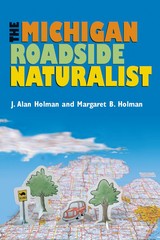 The Michigan Roadside Naturalist
J. Alan Holman and Margaret B. Holman
University of Michigan Press, 2003 Did you know . . . ? - Michigan is seventeenth in oil production in the United States.
- The Great Lakes are said to be the only glacially produced structures that can be seen from the moon.
- Michigan was once part of a coral reef.
- The wood frog is one of the commonest true frogs of moist woodland floors in Michigan today and is able to freeze solid during the winter without harmful effects.
These and many more amazing facts await the curious traveler in The Michigan Roadside Naturalist, J. Alan and Margaret B. Holman's captivating guide to the natural treasures of Michigan. A perfect accompaniment to the classic Michigan Trees and The Forests of Michigan, this user-friendly guide offers a Who's Who of the geology, biology, and archaeology of the Great Lakes State, as well as highway adventures along the state's major routes. The book begins with an educational yet accessible tour of important points in Michigan's natural and archaeological history, followed by seven road trips based on commonly traveled state routes, moving from south to north in the Lower Peninsula and east to west in the Upper Peninsula. Readers can proceed directly to the road trips or familiarize themselves with the state's treasure trove of fascinating features before embarking. Either way, an informative and fun odyssey awaits the passionate naturalist, amateur or otherwise. J. Alan Holman is Curator Emeritus of Vertebrate Paleontology at the Michigan State University Museum and Emeritus Professor of Geology and Zoology at Michigan State University. Margaret B. Holman is Research Associate at Michigan State University Museum and Department of Anthropology, Michigan State University.
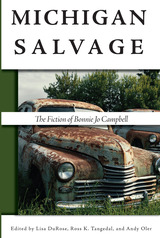 Michigan Salvage: The Fiction of Bonnie Jo Campbell
Lisa DuRose
Michigan State University Press, 2023 Michigan Salvage is the first scholarly collection on celebrated writer Bonnie Jo Campbell, the author of two novels and three short story collections, including National Book Award finalist American Salvage (2009). Her writing captures a diverse and bustling rural America, brimming with complex characters who struggle with addiction, poverty, and land degradation—issues that have become, undeniably, part of the southwestern Michigan landscape that she calls home. The essays in this volume demonstrate many rich ways to approach Campbell’s writing, from historical and cultural overviews to essays examining the class and gender implications of her stories and novels, to teaching essays highlighting how to use her work in the classroom and beyond. Along with each essay, Michigan Salvage also features lesson plans and writing prompts meant to spark discussion and encourage further investigation into these stories and novels. This essential and teachable collection makes plain Campbell’s contributions to contemporary American literature.
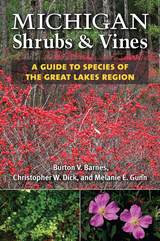 Michigan Shrubs and Vines: A Guide to Species of the Great Lakes Region
Burton V. Barnes, Christopher W. Dick, and Melanie E. Gunn
University of Michigan Press, 2016 Shrubs and vines are some of the most diverse and widespread plants in the Great Lakes Region. Michigan Shrubs and Vines is the must-have book for anyone who wishes to identify and learn about these fascinating plants. Presented in the same attractive, easy-to-use format as the classic Michigan Trees, the book gives detailed descriptions of 132 species, providing concise information on key characters, habitat, distribution, and growth pattern. Precise line drawings accompany each species description and illustrate arrangement and characteristics of leaves, flowers, and fruits in addition to stem structure to assist with reliable year-round identification. A thorough introduction covers the features and forms of shrubs and vines as well as their natural history, their role in landscape ecosystems, and their occurrence in regional ecosystems of North America and plant communities of the Great Lakes. This long awaited companion to Michigan Trees will appeal to botanists, ecologists, students, and amateur naturalists alike.
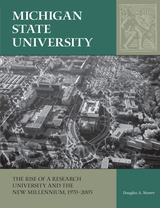 Michigan State University: The Rise of a Research University and the New Millennium, 1970-2005
Douglas A. Noverr
Michigan State University Press, 2015 In the 1960s and ’70s, Michigan State College transformed into the major research institution known today as Michigan State University, a true “megaversity.” Michigan State University, the final volume of this trilogy, explores the history of that transformation and the growing pains the school endured as it became a part of the Association of American Universities. From President John A. Hannah’s vision, the new university has been defined by rapid expansion, growth, new opportunities, and the occasional crisis. Its development has been a massive undertaking that marshaled individuals, research interests, federal funds, state appropriations, and more.
Through the vicissitudes of government funding and other challenges, the university has established itself as a renowned research and educational institution with a remarkably rich array of facilities, scientists, and researchers who continue to make landmark contributions to their fields. At the same time it has strived to be known for its accessibility, diversity, equality of opportunity, and antidiscrimination policies and practices. Michigan State University sheds new light on the growth of this dynamic and multifaceted institution.
Michigan Supreme Court Historical Reference Guide, 2nd Edition
David Chardavoyne
Michigan State University Press, 2015 This second edition of the Michigan Supreme Court Historical Reference Guide contains the biographies of Michigan Supreme Court’s justices from its territorial beginnings in 1803 through 2015. It includes summaries of twenty top cases of the Michigan Supreme Court, which contextualize the eras in which the justices were on the bench, giving a greater depth of understanding to both who the justices were and the historical significance of the cases they decided. A rich reference for historians and attorneys, this book also includes valuable charts detailing election dates and candidates as well as court compositions (who served with whom); lists of chief justices and the ten longest—and shortest—serving justices with dates of service; and a history of the structural evolution of the Michigan Supreme Court.
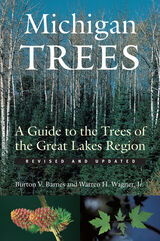 Michigan Trees, Revised and Updated: A Guide to the Trees of the Great Lakes Region
Burton V. Barnes and Warren H. Wagner, Jr.
University of Michigan Press, 2004 Now in its tenth decade of publication, Michigan Trees has been, since it was first introduced in 1913, the must-have reference book for anyone who wants to know about the trees of this unique North American region. In this new and updated edition, several new species have been added to the lineup, as well as sections on tree ecology and fall color. Written and illustrated in a style that appeals at once to academic botanists and armchair arborphiles alike, Michigan Trees gives readers everything they need to know for identifying trees in the Great Lakes state. Included with each description are fascinating notes and asides (for example, this tidbit on the jack pine: "Parklike or savanna stands in north-central Michigan are prime habitat for the rare Kirtland's warbler that breeds nowhere else in the world."). Also includes a tree key and identification section illustrated with elegantly simple line drawings that reveal the tiny, signature details that make each tree unique. Burton V. Barnes is Professor of Forestry at the University of Michigan. Formerly a research forester, he is best known for his research and publications in forest ecology and forest genetics. Warren H. Wagner, Jr. was a world authority on ferns. He had been Professor Emeritus of Botany and Natural Resources at the University of Michigan before his death at the age of 80 in 2000.
Michigan Visions of Our Past
Richard J. Hathaway
Michigan State University Press, 1989 Several Michigan scholars believe there is much to learn from Michigan's colorful history. People study history to learn about the growth and experiences of their forebears, how they shaped the land we know today. One can gain much more from this study, however, if the lessons are used as a guide in making today's decisions.
Throughout the history of michigan, many problems occur and recur: satisfying a diverse population, economic booms and busts, business and labor conflicts, religion in public education, environmental concerns.
A number of writers collaborated to bring such themes to light in 18 illuminating essays. The collection provides a tool for the teacher, a sourse for the scholar, and a pleasurable trip through Michigan history. Michigan: Visions of Our Past, also provides a challenge; a challenge to citizens to understand the past, and apply its lessons to the future of Michigan.
 Michigan's Capitol: Construction and Restoration
William Seale
University of Michigan Press, 1995 Michigan's Capitol: Construction and Restoration is the history of a great American landmark, one among fifty statehouses. Construction of Michigan's State Capitol began in 1871, six years after the close of the Civil War, and was brought to completion less than a decade later. It has survived for more than a century to become the object of one of America's most authentic restorations. This volume allows the reader to chronicle the building and restoration of Michigan's Capitol through words and magnificent color and black-and-white photographs. An archive of treasured historical images, beginning with a group scene at the time the cornerstone was placed, is also included alongside original architectural drawings and sketches. Michigan's Capitol: Construction and Restoration is not only the history of a great vision realized, but a celebration of the rediscovery and revival of that vision in the 1980s and 1990s culminating in one of the most comprehensive restorations ever carried out on an American building. The author, William Seale, a part of the restoration team for Michigan's Capitol from the start, has written extensively about many American buildings, including the White House. Written in a lively, narrative style accessible to readers of all ages, Michigan's Capitol: Construction and Restoration is an especially useful introduction to the art of building as well as the politics of public building.
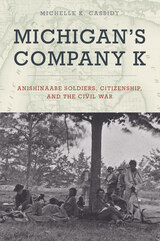 Michigan's Company K: Anishinaabe Soldiers, Citizenship, and the Civil War
Michelle K Cassidy
Michigan State University Press, 2023 As much as the Civil War was a battle over the survival of the United States, for the men of Company K of the First Michigan Sharpshooters, it was also one battle in a longer struggle for the survival of Anishinaabewaki, the homelands of the Anishinaabeg—Ojibwe, Odawa, and Boodewaadamii peoples . The men who served in what was often called ‘the Indian Company’ chose to enlist in the Union army to contribute to their peoples’ ongoing struggle with the state and federal governments over status, rights, resources, and land in the Great Lakes. This meticulously researched history begins in 1763 with Pontiac’s War, a key moment in Anishinaabe history. It then explores the multiple strategies the Anishinaabeg deployed to remain in Michigan despite federal pressure to leave. Anishinaabe men claimed the rights and responsibilities associated with male citizenship—voting, owning land, and serving in the army—while actively preserving their status as ‘Indians’ and Anishinaabe peoples. Indigenous expectations of the federal government, as well as religious and social networks, shaped individuals’ decisions to join the U.S. military. The stories of Company K men also broaden our understanding of the complex experiences of Civil War soldiers. In their fight against removal, dispossession, political marginalization, and loss of resources in the Great Lakes, the Anishinaabeg participated in state and national debates over citizenship, allegiance, military service, and the government’s responsibilities to veterans and their families.
Michigan's Con-Con 11: Women and State Constitution-making in 1961
Lynn Liberato
Michigan State University Press, 2025 Michigan’s Con-Con 11 highlights the contributions of the eleven female delegates to the 1961–1962 Michigan Constitutional Convention. As the first female delegates to a state of Michigan constitutional convention, these pioneers demonstrated that women were more than capable of helping to revise Michigan’s highest law. Their examples encouraged other women to enter politics during a time when few women held state or federal public office. Following the women’s Con-Con journey over seven and a half months, the book offers a general overview of what a state constitutional convention is and what it means to be a delegate. Michigan’s Con-Con 11 both educates the reader on constitution-making and sheds new light on an exciting moment in Michigan political history.
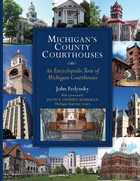 Michigan's County Courthouses
John Fedynsky
University of Michigan Press, 2011 John Fedynsky documents in narrative and photos every county courthouse of Michigan's eighty-three counties, as well as the Michigan Hall of Justice. These buildings are symbols: physically they stand, but figuratively they speak. They embody the purposes for which they were created: law, order, justice, and the promise of a better tomorrow. Fedynsky tells the story of each building. For Michigan, the typical evolution begins in the cabin, tavern, or hotel of a prominent local settler and progresses through incarnations of simple log or wooden clapboard, and then opulent stone or brick, before the structure arrives in modern and utilitarian form. But there are myriad exceptions to this rule, and they add to the diversity of Michigan's county courthouses. In Fedynsky's descriptions, verifiable facts and local lore weave together in dramatic tales of outrageous crime, courtroom intrigue, backroom dealing, jury determination, and judicial prerogative. Released jail inmates assist with evacuating and extinguishing a courthouse fire, residents during a natural disaster seek and find physical refuge behind the sure walls of the courthouse, and vigilant legions of homebound defenders are stationed in wartime throughout the courthouse towers scanning the skies for signs of foreign aircraft. Then there are the homey touches that emphasize the "house" half of Michigan's courthouses: local folks dropping off plants in the courthouse atrium to use it as a winter greenhouse, cows grazing on the public square, county fairs in or near the courthouse, and locally made artwork hanging in public hallways. The courthouses bear within their walls a richness of soul endowed by the good people who make each one special. Cover design by Heidi Dailey Cover photos: John Fedynsky
Michigan's Economic Future: A New Look
Charles Ballard
Michigan State University Press, 2010 This accessible, engaging text examines the impact of the trends that have shaped Michigan’s economy, and offers innovative solutions to the current economic crisis. Charles Ballard’s illuminating book explores the structure of Michigan’s economy, including its roots in agriculture, the rise and fall of the automotive industry, and the long-term decline of manufacturing. Ballard proposes that investing in education to create a highly skilled workforce can help Michigan’s people to compete in the rapidly evolving global economy. Discussing the state’s transportation infrastructure, environment, public expenditures, and tax system, Ballard describes how changes in attitudes, policies, and political institutions will help to promote economic recovery and growth.
Michigan’s Fiscal and Economic Structure
Harvey E. Brazer, Editor; Deborah S. Laren, Assistant Editor
University of Michigan Press, 1982 The first goal of Michigan’s Fiscal and Economic Structure is to present an objective picture of the state’s revenue system, its public expenditures, and its economy. Even if one views the fiscal system as a whole as being in relatively good shape, however, there are bound to be important ways in which the system can be improved, ways in which important flaws can be removed. The authors’ second objective,, therefore, is to attempt to point up the system’s deficiencies and to explore alternative means of eliminating or ameliorating them.
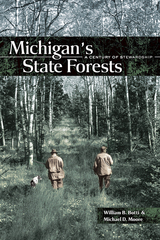 Michigan's State Forests: A Century of Stewardship
William B. Botti
Michigan State University Press, 2006 It has been said that Michigan’s nineteenth century white pine stands were the finest the world has ever seen. Dense, parklike stands, more than 150 feet tall, covered vast areas northward from the Bay City– Muskegon line. The sheer quantity of timber lured many adventurous entrepreneurs and enterprising farmers to Michigan. Lumber became a mainstay of Michigan’s economy as logging interests and railroad entrepreneurs became adept at harvesting, transporting, and processing pine logs. Many considered the pine to be practically limitless.
In October of 1871, the first indication of a troubled future occurred when Michigan settlers experienced fires unlike any they had ever seen. Following two months of serious drought, and fed by hundreds of small fires set by land-clearing operations, much of northern Lower Michigan erupted in flames; dry winds fanned the many small fires into one unbelievable conflagration that swept entirely across the Lower Peninsula, from Lake Michigan to Lake Huron. Many towns were reduced to ashes, among them Holland, Glen Haven, Huron City, Sand Beach, White Rock, and Forestville. Navigation was interrupted on Lake Huron and as far downriver as Detroit because of the heavy smoke. More than 200 people lost their lives.
Michigan’s State Forests recounts how an abandoned, cutover, and often burned wilderness has been converted once again into highly productive and protected public lands. For more than 100 years, these lands have been preserved, managed and developed to form one of Michigan’s great assets, not only for economic development but also as enhancements to our quality of life.
Michigan's Town and Country Inns, 5th Edition
Susan Newhof
University of Michigan Press, 2013 The fifth edition of Michigan’s Town & Country Inns is a guide to more than 50 inns, bed-and-breakfast homes, and historic lodgings in the Upper and Lower Peninsulas of Michigan. Choose from lighthouses anchored to the rugged shores of Lake Superior, Victorian mansions built by lumber and mining barons, rustic log lodges, and romantic small town hideaways. Meet the innkeepers themselves, who range from retired military officers and corporate heads to artists and poets. You’ll find detailed descriptions of the accommodations along with information about rates, suitability for children, and policies on smoking and pets. Get a sense of the flavor and mood of each and learn about fun things to do in the surrounding areas. Numerous photos enhance the descriptions and provide a visitor’s-eye view of some of the most unusual and delightful places to stay in Michigan.
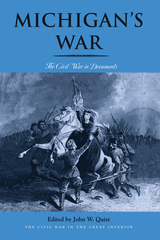 Michigan’s War: The Civil War in Documents
John W. Quist
Ohio University Press, 2018 When it came to the Civil War, Michiganians never spoke with one voice. At the beginning of the conflict, family farms defined the southern Lower Peninsula, while a sparsely settled frontier characterized the state’s north. Although differing strategies for economic development initially divided Michigan’s settlers, by the 1850s Michiganians’ attention increasingly focused on slavery, race, and the future of the national union. They exchanged charges of treason and political opportunism while wrestling with the meanings of secession, the national union, emancipation, citizenship, race, and their changing economy. Their actions launched transformations in their communities, their state, and their nation in ways that Americans still struggle to understand. Building upon the current scholarship of the Civil War, the Midwest, and Michigan’s role in the national experience, Michigan’s War is a documentary history of the Civil War era as told by the state’s residents and observers in private letters, reminiscences, newspapers, and other contemporary sources. Clear annotations and thoughtful editing allow teachers and students to delve into the political, social, and military context of the war, making it ideal for classroom use.
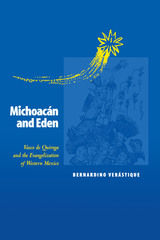 Michoacán and Eden: Vasco de Quiroga and the Evangelization of Western Mexico
By Bernardino Verástique
University of Texas Press, 2000 Don Vasco de Quiroga (1470-1565) was the first bishop of Michoacán in Western Mexico. Driven by the desire to convert the native Purhépecha-Chichimec peoples to a purified form of Christianity, free of the corruptions of European Catholicism, he sought to establish New World Edens in Michoacán by congregating the people into pueblo-hospital communities, where mendicant friars could more easily teach them the fundamental beliefs of Christianity and the values of Spanish culture. In this broadly synthetic study, Bernardino Verástique explores Vasco de Quiroga's evangelizing project in its full cultural and historical context. He begins by recreating the complex and not wholly incompatible worldviews of the Purhépecha and the Spaniards at the time of their first encounter in 1521. With Quiroga as a focal point, Verástique then traces the uneasy process of assimilation and resistance that occurred on both sides as the Spaniards established political and religious dominance in Michoacán. He describes the syncretisms, or fusions, between Christianity and indigenous beliefs and practices that arose among the Purhépecha and relates these to similar developments in other regions of Mexico. Written especially for students and general readers, this book demonstrates how cultural and geographical environments influence religious experience, while it adds to our understanding of the process of indigenous appropriation of Christian theological concepts in the New World.
Mickery Theater: An Imperfect Archaeology
Mike Pearson
Amsterdam University Press, 2011 This is the first full-length study of the history and working practices of the Mickery Theater in Amsterdam. Between 1965 and 1991, under its noted director Ritsaert ten Cate, Mickery became renowned worldwide for promoting and presenting significant international alternative theatre companies, and for staging its own innovative productions. Through a unique “archaeological” approach, combining archival research, oral history, and field observation, this book establishes the singular importance of Mickery and evokes the unique atmosphere of both the building and the activities it nurtured.
“A superbly realized biography of an experimental theater. The full life of Mickery emerges through a rich assemblage of people and events.”—Edward Scheer, University of New South Wales
 Mickey’s Harvest: A Novel of a Deaf Boy’s Checkered Life
Howard L. Terry
Gallaudet University Press, 2015 Howard L. Terry wrote a novel between 1917 and 1922, which he donated to the Gallaudet University Archives in 1951. There it rested until a resurgence of interest in Deaf literature led to its recent rediscovery. Mickey’s Harvest: A Novel of a Deaf Boy’s Checkered Life recounts the rollicking tale of a young deaf man and how he learned to survive and thrive at the advent of the 20th century.
Mickey Dunmore’s story begins with the sinking of his father’s merchant sailing ship and ends with a cliffhanger in World War I. In school, after an illness caused his deafness, Mickey finds himself constantly fighting the hearing boys and later competing with the signing students when he attends a residential school for deaf students. In college, he and his best friend Dick Wagner leave early to travel the nation with the hobos, carnies, and grifters. In one town, they outfox a barker who was using a deaf girl to “read” the minds of their marks. Further on, they meet Bunny, the Mighty Mite deaf man who helps expose a hearing woman posing as deaf to scam sympathetic people. Mickey faces his greatest challenge when he falls in love with Marion Carrel, a deaf girl whose hearing father forbids their romance on eugenics grounds.
Terry, who became deaf at the age of 11, states from the outset that he means for his novel to reveal the biases confronting deaf people at the time. As a tonic, he populates Mickey’s Harvest with artistic, talented deaf individuals who engage readers in an earlier, colorful time as they “show their stuff.”
 The Micmac Indians of Eastern Canada
Wilson D. Wallis and Ruth Sawtell Wallis
University of Minnesota Press, 1955 The Micmac Indians of Eastern Canada was first published in 1955. Minnesota Archive Editions uses digital technology to make long-unavailable books once again accessible, and are published unaltered from the original University of Minnesota Press editions. The culture of an Indian tribe over a period of 300 years is described in this comprehensive ethnographic study by a husband and wife anthropologist team. The earliest accounts of the Micmac Indians were written by seventeenth-century French explorers and missionaries. These give historical perspective to the work done by the Wallises, whose research is based on field trips that bridged a 40-years span. Dr. Wallis first observed the Micmac tribes in 1911–12. He and Mrs. Wallis revisited them in 1950 and 1953, assessing the changes in material cultural and in orientation, drives, and motivations. In addition, they have preserved a rich collection of Micmac folktales and traditions, published as a separate section of the book.
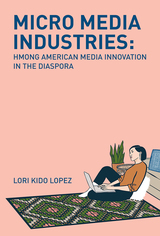 Micro Media Industries: Hmong American Media Innovation in the Diaspora
Lori Kido Lopez
Rutgers University Press, 2021 With the rise of digital tools used for media entrepreneurship, media outlets staffed by only one or two individuals and targeted to niche and super-niche audiences are developing across a wide range of platforms. Minority communities such as immigrants and refugees have long been pioneers in this space, operating ethnic media outlets with limited staff and funding to produce content that is relevant and accessible to their specific community. Micro Media Industries explores the specific case of Hmong American media, showing how an extremely small population can maintain a robust and thriving media ecology in spite of resource limitations and an inability to scale up. Based on six years of fieldwork in Hmong American communities in Wisconsin, Minnesota, and California, it analyzes the unique opportunities and challenges facing Hmong newspapers, radio, television, podcasts, YouTube, social media, and other emerging platforms. It argues that micro media industries, rather than being dismissed or trivialized, ought to be held up as models of media innovation that can counter the increasing power of mainstream media.
 Microbes from Hell
Patrick Forterre
University of Chicago Press, 2016 At the close of the 1970s, the two-domain classification scheme long used by most biologists—prokaryotes versus eukaryotes—was upended by the discovery of an entirely new group of organisms: archaea. Initially thought to be bacteria, these single-celled microbes—many of which were first found in seemingly unlivable habitats like the volcanic hot springs of Yellowstone National Park—were in fact so different at molecular and genetic levels as to constitute a separate, third domain beside bacteria and eukaryotes. Their discovery sparked a conceptual revolution in our understanding of the evolution of life, and Patrick Forterre was—and still is—at the vanguard of this revolution.
In Microbes from Hell, one of the world’s leading experts on archaea and hyperthermophiles, or organisms that have evolved to flourish in extreme temperatures, offers a colorful, engaging account of this taxonomic upheaval. Blending tales of his own search for thermophiles with discussions of both the physiological challenges thermophiles face and the unique adaptations they have evolved to live in high-temperature environments, Forterre illuminates our developing understanding of the relationship between archaea and the rest of Earth’s organisms. From biotech applications to the latest discoveries in thermophile research, from microbiomes to the communities of organisms that dwell on deep-sea vents, Forterre’s exploration of life-forms that seem to thrive at the mouth of hell provides a glimpse into the early days of Earth, offering deep insight into what life may have looked like in the extreme environments of our planet’s dawn.
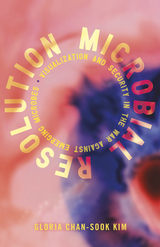 Microbial Resolution: Visualization and Security in the War against Emerging Microbes
Gloria Chan-Sook Kim
University of Minnesota Press, 2024 An interdisciplinary study charting the war against microbial futures leads to a new theory of contemporary vision and visuality
In 1989, a group of U.S. government scientists met to discuss some surprising findings: new diseases were appearing around the world, and viruses that they thought long vanquished were resurfacing. Their appearance heralded a future perpetually threatened by unforeseeable biological risks, sparking a new concept of disease: the “emerging microbe.” With the Cold War nearing its end, American scientists and security experts turned to confront this new “enemy,” redirecting national security against its risky horizons. In order to be fought, emerging microbes first needed to be made perceptible; but how could something immaterial, unknowable, and ever mutating be coaxed into visibility, knowability, and operability? Microbial Resolution charts the U.S.-led war on the emerging microbe to show how their uncertain futures were transformed into objects of global science and security. Moving beyond familiar accounts that link scientific knowledge production to optical practices of visualizing the invisible, Gloria Chan-Sook Kim develops a theory of “microbial resolution” to analyze the complex problematic that arises when dealing with these entities: what can be seen when there is nothing to see? Through a syncretic analysis of data mining, animal-tracking technologies, media networks, computer-modeled futures, and global ecologies and infrastructures, she shows how a visual impasse—the impossibility of seeing microbial futures—forms the basis for new modes of perceiving, knowing, and governing in the present. Timely and thought provoking, Microbial Resolution opens up the rich paradoxes, irreconcilabilities, and failures inherent in this project and demonstrates how these tensions profoundly animate twenty-first-century epistemologies, aesthetics, affects, and ecologies.
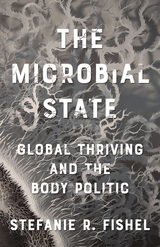 The Microbial State: Global Thriving and the Body Politic
Stefanie R. Fishel
University of Minnesota Press, 2017 For three centuries, concepts of the state have been animated by one of the most powerful metaphors in politics: the body politic, a claustrophobic and bounded image of sovereignty. Climate change, neoliberalism, mass migration, and other aspects of the late Anthropocene have increasingly revealed the limitations of this metaphor. Just as the human body is not whole and separate from other bodies—comprising microbes, bacteria, water, and radioactive isotopes—Stefanie R. Fishel argues that the body politic of the state exists in dense entanglement with other communities and forms of life. Drawing on insights from continental philosophy, science and technology studies, and international relations theory, this path-breaking book critiques the concept of the body politic on the grounds of its very materiality. Fishel both redefines and extends the metaphor of the body politic and its role in understanding an increasingly posthuman, globalized world politics. By conceiving of bodies and states as lively vessels, living harmoniously with multiplicity and the biosphere, she argues that a radical shift in metaphors can challenge a politics based on fear to open new forms of global political practice and community. Reframing the concept of the body politic to accommodate greater levels of complexity, Fishel suggests, will result in new configurations for the political and social organization necessary to build a world in which the planet’s inhabitants do not merely live but actively thrive.
Micro-Doppler Radar and its Applications
Francesco Fioranelli
The Institution of Engineering and Technology, 2020 This book covers the latest developments in radar micro-Doppler signatures and non-cooperative recognition of moving targets, for researchers and advanced students of radar systems. Micro-Doppler signatures is a very broad topic with applications in healthcare, security and surveillance. Edited by leading researchers in the field, the book consists of a series of chapters with contributions from different groups of authors who are international experts on their topics.
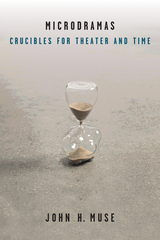 Microdramas: Crucibles for Theater and Time
John H. Muse
University of Michigan Press, 2017 In Microdramas, John H. Muse argues that plays shorter than twenty minutes deserve sustained attention, and that brevity should be considered a distinct mode of theatrical practice. Focusing on artists for whom brevity became both a structural principle and a tool to investigate theater itself (August Strindberg, Maurice Maeterlinck, F. T. Marinetti, Samuel Beckett, Suzan-Lori Parks, and Caryl Churchill), the book explores four episodes in the history of very short theater, all characterized by the self-conscious embrace of brevity. The story moves from the birth of the modernist microdrama in French little theaters in the 1880s, to the explicit worship of speed in Italian Futurist synthetic theater, to Samuel Beckett’s often-misunderstood short plays, and finally to a range of contemporary playwrights whose long compilations of shorts offer a new take on momentary theater.
Subjecting short plays to extended scrutiny upends assumptions about brief or minimal art, and about theatrical experience. The book shows that short performances often demand greater attention from audiences than plays that unfold more predictably. Microdramas put pressure on preconceptions about which aspects of theater might be fundamental and about what might qualify as an event. In the process, they suggest answers to crucial questions about time, spectatorship, and significance.
Microeconomic Laws: A Philosophical Analysis
Alexander Rosenberg
University of Pittsburgh Press, 1976 Rosenberg applies current thinking in philosophy of science to neoclassical economics in order to assess its claims to scientific standing. Although philosophers have used history and psychology as paradigms for the examination of social science, there is good reason to believe that economics is a more appropriate subject for analysis: it is the most systematized and quantified of the social sciences; its practitioners have reached a measure of consensus on important aspects of their subject; and it encompasses a large number of apparently law-like propositions.
Microeconomics: A Critical Companion
Ben Fine
Pluto Press, 2016 The culmination of forty years of teaching, researching, and advising on political economy, Ben Fine’s Microeconomics offers a clear and concise exposition of mainstream microeconomics from a heterodox perspective. Covering topics from consumer and producer theory to general equilibrium to perfect competition, it sets the emergence and evolution of microeconomics in both its historical and interdisciplinary context. Fine critically exposes the methodological and conceptual content of dominant microeconomic models without sacrificing the technical detail required for those completing a first degree in economics or entering postgraduate study. The result is a book which is sure to establish a strong presence on undergraduate reading lists and in comparative literature on the subject.
Micro-Enterprise and Personalisation: What Size Is Good Care?
Catherine Needham, Kerry Allen, and Kelly Hall
Bristol University Press, 2017 Social service agencies in the United Kingdom are increasingly under pressure to provide personalized care, even as the larger climate of austerity puts pressure on their resources. Increasingly, this means that community-based organizations of five or fewer staff members—known as microenterprises—are being asked to handle work that was formerly the province of much larger providers. In part, this is rooted in the assumption that small organizations can be more innovative and responsive. This book tests that assumption, analyzing the work of care organizations with a specific focus on size and how it affects personalization and the quality of care.
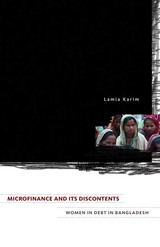 Microfinance and Its Discontents: Women in Debt in Bangladesh
Lamia Karim
University of Minnesota Press, 2010 A feminist critique of the much-lauded microcredit process in Bangladesh
In 2006 the Grameen Bank of Bangladesh won the Nobel Peace Prize for its innovative microfinancing operations. This path-breaking study of gender, grassroots globalization, and neoliberalism in Bangladesh looks critically at the Grameen Bank and three of the leading NGOs in the country. Amid euphoria over the benefits of microfinance, Lamia Karim offers a timely and sobering perspective on the practical, and possibly detrimental, realities for poor women inducted into microfinance operations.
In a series of ethnographic cases, Karim shows how NGOs use social codes of honor and shame to shape the conduct of women and to further an agenda of capitalist expansion. These unwritten policies subordinate poor women to multiple levels of debt that often lead to increased violence at the household and community levels, thereby weakening women’s ability to resist the onslaught of market forces.
A compelling critique of the relationship between powerful NGOs and the financially strapped women beholden to them for capital, this book cautions us to be vigilant about the social realities within which women and loans circulate—realities that often have adverse effects on the lives of the very women these operations are meant to help.
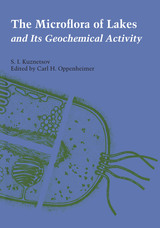 The Microflora of Lakes and Its Geochemical Activity
By S. I. Kuznetsov
University of Texas Press, 1975 The geochemical processes that take place in water bodies do not stem entirely from the activity of bacteria, but are also determined by the biological activity of higher plants and animals. The Microflora of Lakes and Its Geochemical Activity, the first English translation of the work of S. I. Kuznetsov, renowned Soviet microbiologist, is a detailed description of these processes.
The Microflora of Lakes opens with a complete outline of the ecology and physical and chemical properties of water bodies and a discussion of the entire complex of hydrobionts, since these factors exert tremendous influence on the microbial population. The work then focuses on the principles of the morphology and physiology of the living cell, background knowledge essential to the understanding of the role of microorganisms in the chemical cycle. Having laid the groundwork for the discussion, Kuznetsov follows with chapters on the distribution of bacteria and transformations of organic matter in lakes. He then examines the role of bacteria in the oxygen regime, and the cycles of organic matter, nitrogen, sulfur, iron, manganese and phosphorus. The last chapter describes the role of microorganisms in sediments of calcium carbonate waters.
The Microflora of Lakes and Its Geochemical Activity provides a wealth of information on the microbial limnology of fresh-water lakes throughout the world, particularly in the Soviet Union. As a summary of the geochemical activities as related to the geographic, geological, and physical relationships of fresh-water lakes, it is a monumental study.
The Microflora of Lakes was translated for the National Science Foundation, Washington, D.C., by the Israel Program for Scientific Translations in Jerusalem.
Micro-Foundations for Innovation Policy
Bart Nooteboom and Erik Stam
Amsterdam University Press, 2008
In economics, business, and government policy, innovation policy requires the creation of new approaches to a whole range of activities. This edited volume engagingly explores the roles of individuals and organizations involved in the creation and application of innovations. Covering topics as diverse as the macro-economic importance of innovation, theories of knowledge and learning, entrepreneurship, education and research, organizational innovation, networks, and regional innovation systems, Micro-Foundations for Innovation Policy provides critical insights into the development of innovation policy.
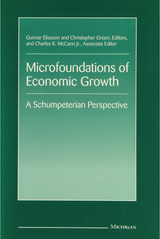 Microfoundations of Economic Growth
Gunnar Eliasson and Christopher Green, Editors, and Charles R. McCann Jr., Associate Editor
University of Michigan Press, 1998 The contributors to this volume seek further understanding of the microfoundations of economic growth. It focuses on three subjects that interested the great Austrian and Harvard economist, Joseph A. Schumpeter: innovation, technological change, and economic growth. The first part of the volume treats institutions, markets, and entrepreneurs, without which analysis of the firm makes little or no sense. The second part focuses on the firm as innovator, placing heavy emphasis on the role of knowledge formation. The subjects of innovation and knowledge formation are approached from three perspectives: theoretical; industry (case) studies; and empirical (cross section and panel data) analysis. In the third part of the book the action moves from the firm to the "macro" or economy-wide level. The volume's unique feature is combining institutions, the innovative behavior of firms, and an intuitively dynamic, macroeconomic analysis, all from a Schumpeterian perspective. It is argued that the study of micro-institutions such as firms and the evolving nature of markets are necessary ingredients to understanding macro-oriented phenomena such as economic growth. It is in this sense, then, that the book is concerned with microfoundations. Contributors are Daniele Archibugi, Spyros Arvanitis, David B. Audretsch, John R. Baldwin, Gerard Ballot, Pontus Braunerhjelm, Dagobert L. Brito, Uwe Cantner, Bo Carlsson, Robert W. Clower, Richard Day, Rinaldo Evangelista, Jan Glete, Horst Hanusch, Heinz Hollenstein, Michael D. Intrilgator, George Johnson, Joanne Johnson, Aija Leiponen, Staffan Laestadius, Richard N. Langlois, Frank M. Machovec, Maureen McKelvey, Valentina Meiciani, Douglass C. North, Giulio Perani, Andreas Pyka, Fabio Rapiti, Roberto Simonetti, Frank Stafford, Paula E. Stephan, Erol Taymaz, Clas Wihlborg, Erica R. Worth, and S. Y. Wu. Gunnar K. Eliasson is Professor of Industrial Economics, Royal Technical Institute (KTH), Stockholm. Christopher Green is Professor of Economics, McGill University. Charles R. McCann, Jr., is Research Associate, Department of Economics, University of Pittsburgh.
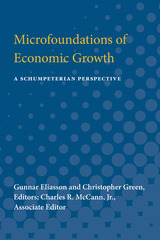 Microfoundations of Economic Growth: A Schumpeterian Perspective
Gunnar Eliasson and Christopher Green, Editors; Charles R. McCann, Jr., Associate Editor
University of Michigan Press, 1998 The contributors to this volume seek further understanding of the microfoundations of economic growth. It focuses on three subjects that interested the great Austrian and Harvard economist, Joseph A. Schumpeter: innovation, technological change, and economic growth. The first part of the volume treats institutions, markets, and entrepreneurs, without which analysis of the firm makes little or no sense. The second part focuses on the firm as innovator, placing heavy emphasis on the role of knowledge formation. The subjects of innovation and knowledge formation are approached from three perspectives: theoretical; industry (case) studies; and empirical (cross section and panel data) analysis. In the third part of the book the action moves from the firm to the "macro" or economy-wide level. The volume's unique feature is combining institutions, the innovative behavior of firms, and an intuitively dynamic, macroeconomic analysis, all from a Schumpeterian perspective. It is argued that the study of micro-institutions such as firms and the evolving nature of markets are necessary ingredients to understanding macro-oriented phenomena such as economic growth. It is in this sense, then, that the book is concerned with microfoundations. Contributors are Daniele Archibugi, Spyros Arvanitis, David B. Audretsch, John R. Baldwin, Gerard Ballot, Pontus Braunerhjelm, Dagobert L. Brito, Uwe Cantner, Bo Carlsson, Robert W. Clower, Richard Day, Rinaldo Evangelista, Jan Glete, Horst Hanusch, Heinz Hollenstein, Michael D. Intrilgator, George Johnson, Joanne Johnson, Aija Leiponen, Staffan Laestadius, Richard N. Langlois, Frank M. Machovec, Maureen McKelvey, Valentina Meiciani, Douglass C. North, Giulio Perani, Andreas Pyka, Fabio Rapiti, Roberto Simonetti, Frank Stafford, Paula E. Stephan, Erol Taymaz, Clas Wihlborg, Erica R. Worth, and S. Y. Wu. Gunnar K. Eliasson is Professor of Industrial Economics, Royal Technical Institute (KTH), Stockholm. Christopher Green is Professor of Economics, McGill University. Charles R. McCann, Jr., is Research Associate, Department of Economics, University of Pittsburgh.
Microfoundations of the Arab Uprisings: Mapping Interactions between Regimes and Protesters
Edited by Frédéric Volpi and James M. Jasper
Amsterdam University Press, 2018 This book brings together a roster of prominent contributors to present a strategic interactionist perspective on the study of contentious politics in the Middle East in response to the Arab uprisings. The common thread among the contributions is an interest in the micro-level interactions between various strategic players, including not only the mobilisation of protestors during the uprisings but also the responses of regimes. The book also examines short to medium-term adaptations of the regimes and the collective action of opponents in the post-uprisings period, as well as the subsequent trajectories of the protesters themselves in the face of new forms of authoritarianism or democratisation.
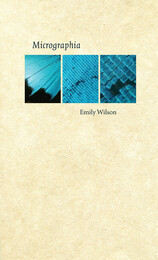 Micrographia
Emily Wilson
University of Iowa Press, 2009 Eight years after her revelatory first book, Emily Wilson deepens her focus and extends her vision in new poems of striking intelligence and originality. Venturing into landscapes both interior and exterior, Micrographia explores what Wilson calls “the complex rigged wildness” of geographical, emotional, and verbal states, a territory located “somewhere in that / enjambment within / a cave within the brain.” Following in the tradition of such poets as Dickinson, Bishop, and Ammons, Wilson’s work regards the mind as “enmeshed” with the natural world, always “at the hinge of going over.” Her way of speaking is as precisely calibrated and as restless as her way of seeing, and the terrain of Micrographia rises from a rich and unpredictable encounter with poetic language and form. At the same time, the voice of these poems is never less than urgent, “coming clear by the foment / moving through it.” Wilson’s eye travels the troubled boundaries between visible and invisible worlds, ranging from coastal Nova Scotia to the Andean highlands to Brooklyn’s industrial Gowanus Canal to the poet’s own backyard. Steeped in tradition but spoken in tones that are utterly distinctive, these intricate poems enter into the microscopic, micrographic spaces between words and things, between thinking and being.
Microgrids and Active Distribution Networks
S. Chowdhury
The Institution of Engineering and Technology, 2009 A companion to Embedded Generation (IET, 2000), this book is a timely publication for an evolving industry. Renewable energy, ancillary services and deregulation of the power industry are changing electricity delivery networks. Microgrids, smartgrids and active distribution networks require a sound understanding of the basic concepts, generation technologies, impacts, operation, control and management, economic viability and market participation involved in grid integration. Practicing engineers in utilities and industry, researchers and students will appreciate this lucid description of the technologies that will enable future electricity systems.
Microgrids for Rural Areas: Research and case studies
Rajeev Kumar Chauhan
The Institution of Engineering and Technology, 2020 Large rural areas in some regions of the world are still grappling with the challenge of electrification. The optimal solution is to provide reliable energy without adding more fossil fuel plants by using distributed renewable generation.
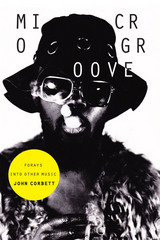 Microgroove: Forays into Other Music
John Corbett
Duke University Press, 2015 Microgroove continues John Corbett's exploration of diverse musics, with essays, interviews, and musician profiles that focus on jazz, improvised music, contemporary classical, rock, folk, blues, post-punk, and cartoon music. Corbett's approach to writing is as polymorphous as the music, ranging from oral history and journalistic portraiture to deeply engaged cultural critique. Corbett advocates for the relevance of "little" music, which despite its smaller audience is of enormous cultural significance. He writes on musicians as varied as Sun Ra, PJ Harvey, Koko Taylor, Steve Lacy, and Helmut Lachenmann. Among other topics, he discusses recording formats; the relationship between music and visual art, dance, and poetry; and, with Terri Kapsalis, the role of female orgasm sounds in contemporary popular music. Above all, Corbett privileges the importance of improvisation; he insists on the need to pay close attention to “other” music and celebrates its ability to open up pathways to new ideas, fresh modes of expression, and unforeseen ways of knowing.
 Microhistories of Composition
Bruce Mccomiskey
Utah State University Press, 2016 Writing studies has been dominated throughout its history by grand narratives of the discipline, but in this volume Bruce McComiskey begins to explore microhistory as a way to understand, enrich, and complicate how the field relates to its past. Microhistory investigates the dialectical interaction of social history and cultural history, enabling historians to examine uncommon sites, objects, and agents of historical significance overlooked by social history and restricted to local effects by cultural history. This approach to historical scholarship is ideally suited for exploring the complexities of a discipline like composition. Through an introduction and eleven chapters, McComiskey and his contributors—including major figures in the historical research of writing studies, such as Louise Wetherbee Phelps, Kelly Ritter, and Neal Lerner—develop focused narratives of particular significant moments or themes in disciplinary history. They introduce microhistorical methodologies and illustrate their application and value for composition historians, contributing to the complexity and adding momentum to the emerging trend within writing studies toward a richer reading of the field’s past and future. Scholars and historians of both composition and rhetoric will appreciate the fresh perspectives on institutional and disciplinary histories and larger issues of rhetorical agency and engagement enacted in writing classrooms that are found in Microhistories of Composition.
Other contributors include Cheryl E. Ball, Suzanne Bordelon, Jacob Craig, Matt Davis, Douglas Eyman, Brian Gogan, David Gold, Christine Martorana, Bruce McComiskey, Josh Mehler, Annie S. Mendenhall, Kendra Mitchell, Antony N. Ricks, David Stock, Kathleen Blake Yancey, Bret Zawilski, and James T. Zebroski.
 Micro-Politics: Agency in a Postfeminist Era
Patricia S. Mann
University of Minnesota Press, 1994 Micro-Politics was first published in 1994. Minnesota Archive Editions uses digital technology to make long-unavailable books once again accessible, and are published unaltered from the original University of Minnesota Press editions. Patricia S. Mann explains our current period as a time of social transformation resulting from an "unmooring" of women, men, and children from the nuclear family, gender relations having replaced economic relations as the primary site of social tension and change in our lives. The feminist movement has evolved, according to Mann, into a popularly based postfeminist struggle to reconstruct relationships between women and men within everyday contexts of work, family, education, and politics. Mann formulates a "postmodern" theory of political agency, utilizing it to explain political events such as the Hill-Thomas Senate hearings and their social aftermath. While liberal and progressive theories have explained political agency in terms of individual or group forms of identity, Mann suggests another alternative. Individuals such as Anita Hill are drawn into socially meaningful struggles in the context of their daily lives-as we all are potentially participating in micro-political forms of activism in a variety of institutional contexts. These dynamic micropolitical situations involve intersecting dimensions of race, class, and sexuality, as well as gender. Within specific conflicts, individuals rearticulate their notions of desire and responsibility, and their expectations for recognition and reward; according to Mann political agency resides in these choices. Addressing some of the most important controversies in political philosophy, Mann weaves together strands of the "participatory politics" of the 1960s and the multicultural politics of the 1990s. In doing so, she offers a new basis for understanding social change.
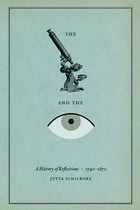 The Microscope and the Eye: A History of Reflections, 1740-1870
Jutta Schickore
University of Chicago Press, 2007 The microscope’s technical capabilities and uses expanded dramatically in the early nineteenth century, when it emerged as an important tool for medical education and played a key role in the development of the cell theory, among other advancements. Focusing on the decades surrounding this crucial period, Jutta Schickore weaves a fascinating story of microscopy by tracing the entwined history of the eye and the optical instrument.
Concentrating on Great Britain and the German lands—home to the period’s most significant developments in microscopy—The Microscope and the Eye examines debates about such subjects as the legitimacy of human trespassing on the microcosm and the nature of light. Schickore also explores the microscope’s role in investigations of the finer structure of the eye and the workings of nerve fibers and the microscopists’ reflections on vision, illusion, artifacts, and the merits of instruments. Fully considering the epistemological, metaphysical, and methodological implications of this centuries-old relationship, The Microscope and the Eye will be an important contribution to the history of the life sciences, vision studies, and scientific methodology.
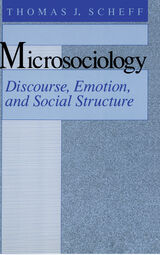 Microsociology: Discourse, Emotion, and Social Structure
Thomas J. Scheff
University of Chicago Press, 1990 Moving beyond the traditional boundaries of sociological investigation,
Thomas J. Scheff brings together the study of communication and the social
psychology of emotions to explore the microworld of thoughts, feelings,
and moods. Drawing on strikingly diverse and rich sources—the findings of
artificial intelligence and cognitive science, and examples from literary
dialogues and psychiatric interviews—Scheff provides an inventive account
of the nature of social life and a theory of motivation that brilliantly
accounts for the immense complexity involved in understanding even the most
routine conversation.
"A major contribution to some central debates in social theory at the
present time. . . . What Thomas Scheff seeks to develop is essentially a
quite novel account of the nature of social life, its relation to language
and human reflexivity, in which he insists upon the importance of a theory
of emotion. . . . A work of true originality and jolting impact. . . .
Microsociology is of exceptional interest, which bears witness to the
very creativity which it puts at the center of human social contact."
—Anthony Giddens, from the Foreword
"Scheff provides a rich theory that can easily generate further exploration. And he drives home the message that sociological work on interaction, social bonds, and society cannot ignore human emotionality."—Candace Clark, American Journal of Sociology
"This outstanding and ground-breaking little volume contains a wealth of original ideas that bring together many insights concerning the relationship of emotion to motivation in a wide variety of social settings. It is strongly recommended to all serious students of emotion, of society, and of human nature."—Melvin R. Lansky, American Journal of Psychiatry
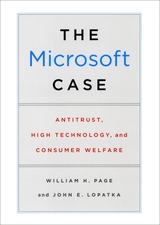 The Microsoft Case: Antitrust, High Technology, and Consumer Welfare
William H. Page and John E. Lopatka
University of Chicago Press, 2007 In 1998, the United States Department of Justice and state antitrust agencies charged that Microsoft was monopolizing the market for personal computer operating systems. More than ten years later, the case is still the defining antitrust litigation of our era. William H. Page and John E. Lopatka’s The Microsoft Case contributes to the debate over the future of antitrust policy by examining the implications of the litigation from the perspective of consumer welfare. The authors trace the development of the case from its conceptual origins through the trial and the key decisions on both liability and remedies. They argue that, at critical points, the legal system failed consumers by overrating government’s ability to influence outcomes in a dynamic market. This ambitious book is essential reading for business, law, and economics scholars as well as anyone else interested in the ways that technology, economics, and antitrust law have interacted in the digital age. “This book will become the gold standard for analysis of the monopolization cases against Microsoft. . . . No serious student of law or economic policy should go without reading it.”—Thomas C. Arthur, Emory University
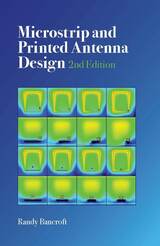 Microstrip and Printed Antenna Design
Randy Bancroft
The Institution of Engineering and Technology, 2009 The approach in this book is historical and practical. It covers basic designs in more detail than other microstrip antenna books that tend to skip important electrical properties and implementation aspects of these types of antennas. Examples include: quarter-wave patch, quarter by quarter patch, detailed design method for rectangular circularly polarized patch, the use of the TM11 (linear and broadside CP), TM21 (monopole CP pattern) and TM02 (monopole linear) circular patch modes in designs, dual-band antenna designs which allow for independent dual-band frequencies. Limits on broadband matching are discussed. The appendix contains useful simple matching approaches, design details (gain, matching, sidelobes) of the little-studied omnidirectional microstrip antenna (OMA), limits and properties of common single and dual band Planar Inverted F Antenna (PIFA) antenna designs. The second edition has numerous additions to the earlier text which will make the concepts presented clearer. New cavity model analysis equations of circular polarization bandwidth, axial ratio bandwidth and power fraction bandwidth have been included. The section on omnidirectional microstrip antennas is expanded with further design options and analysis. This is also true of the section on Planar Inverted F (PIFA) antennas. The discovery and description of the fictious resonance mode of a microstrip slot antenna has been added to that section. Appendix A, on microstrip antenna substrates has been expanded to provide more detail on the types of substrate and their composition. This is often neglected in other texts. An appendix on elementary impedance matching techniques has been added as these methods have proven useful in my industrial work.
Microstrip and Printed Antenna Design
Randy Bancroft
The Institution of Engineering and Technology, 2020 This thoroughly updated third edition of this popular book covers all types of printed microstrip antenna design, from rectangular to circular, broadband and dual band, and millimeter wave microstrip antenna to microstrip arrays.
Microstrip Antenna Theory and Design
J.R. James
The Institution of Engineering and Technology, 1981 In the past few years, the concept of creating microwave antennas using microstrip has attracted increasing attention and viable practical designs are now emerging. The purpose of this monograph is to present the reader with an appreciation of the underlying physical action, up-to-date theoretical treatments, useful antenna design approaches and the overall state-of-the-art situation. The emphasis is on antenna engineering design, but to achieve this goal it has been necessary to delve into the behaviour of microstrip in a much wider sense and also include aspects of electromagnetic analysis. As a consequence, the monograph will also be of interest to microstrip circuit designers and to some extent those seeking electromagnetic problems of a challenging nature.
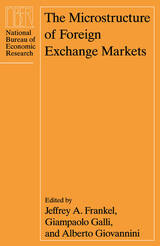 The Microstructure of Foreign Exchange Markets
Edited by Jeffrey A. Frankel, Giampaolo Galli, and Alberto Giovannini
University of Chicago Press, 1996 The foreign exchange market is the largest, fastest-growing financial market in the world. Yet conventional macroeconomic approaches do not explain why people trade foreign exchange. At the same time, they fail to explain the short-run determinants of the exchange rate.
These nine innovative essays use a microstructure approach to analyze the workings of the foreign exchange market, with special emphasis on institutional aspects and the actual behavior of market participants. They examine the volume of transactions, heterogeneity of traders, the time of day and location of trading, the bid-ask spread, and the high level of exchange rate volatility that has puzzled many observers. They also consider the structure of the market, including such issues as nontransparency, asymmetric information, liquidity trading, the use of automated brokers, the relationship between spot and derivative markets, and the importance of systemic risk in the market.
This timely volume will be essential reading for anyone interested in the economics of international finance.
Microwave Antenna Theory and Design
Samuel Silver
The Institution of Engineering and Technology, 1984 Microwave Antenna Theory and Design is an unabridged reprint of the book published by McGraw Hill, as Volume 12 of the MIT Radiation Laboratory Series in 1949. The Editor of the Volume, the late Professor Samuel Silver, contributed extensively to the text and subsequently became one of the best known people in the world of radio science.
Microwave Circuit Theory and Foundations of Microwave Metrology
Glenn F. Engen
The Institution of Engineering and Technology, 1992 No system in science or engineering can be successfully designed, analysed and specified unless it is backed up by precise quantitative measurements. This is particularly difficult in the field of microwaves where, more often than not, the parameter(s) of interest cannot be observed directly but must be inferred from the measurement of other related parameters. Although the advent of the automated network analyser has eliminated much of the previous drudgery, the problems of interpreting the digitally displayed information still remain. One purpose of this book is to provide the reader with a thorough understanding of the microwave circuit model and its limitations, and thus eliminate the many potential pitfalls that otherwise await the unwary experimenter.
Microwave Field-Effect Transistors: Theory, design and applications
Raymond S. Pengelly
The Institution of Engineering and Technology, 1994 This book covers the use of devices in microwave circuits and includes such topics as semiconductor theory and transistor performance, CAD considerations, intermodulation, noise figure, signal handling, S-parameter mapping, narrow- and broadband techniques, packaging and thermal considerations. Perhaps the most comprehensive text on GaAs FET technology and its practical application. It covers the use of MESFET devices in microwave circuits, such as low-noise amplifiers, mixers, oscillators, power amplifiers, switches and multipliers. This text is a classic reference for all engineers involved in the development of solid state microwave devices.
Microwave Horns and Feeds
A.D. Olver
The Institution of Engineering and Technology, 1994 This book is the first comprehensive treatment of microwave horns and feeds for reflector antennas for use in satellite and terrestrial communications, radar and radio astronomy. The feed for a reflector antenna is a crucial component because the performance of the reflector depends on a good feed to collect or radiate signals.
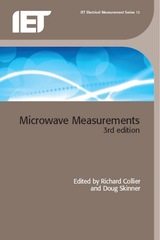 Microwave Measurements
R.J. Collier
The Institution of Engineering and Technology, 2007 The IET has organised training courses on microwave measurements since 1983, at which experts have lectured on modern developments. The purpose of this third edition of the lecture notes is to bring the latest techniques in microwave measurements to a wider audience. The book includes a survey of the theory of current microwave circuits as well as a description of the techniques for the measurement of power, spectrum, attenaution, circuit parameters, and noise, measurements of antenna characteristics, free fields, modulation and dielectric parameters. The emphasis throughout is on good measurement practice. All the essential theory is given and a previous knowledge of the subject is not assumed. The book will be of interest to those engaged in the design of microwave measurement systems in both research and industry, those providing microwave measurement systems in both research and industry, in measurement services and those involved in teaching microwave measurements in universities.
Microwave Receivers with Electronic Warfare Applications
James Bao-Yen Tsui
The Institution of Engineering and Technology, 2005 This book is a treatise on EW receivers that is relevant to you if you are just looking for a top-level insight into EW receivers or need to know the intricate details of cause and effect behavior in EW receiver theory and design. The book begins with a general discussion of EW receivers in their functional context and then goes into just the right amount of detail about the theoretical characteristics common to all receiver designs. Examples of this include receiver design issues impacting probability of detection, false alarm rate, and dynamic range performance. Tsui then describes the important characteristics of key emitter parameters to be measured by an EW receiver. He goes on to systematically cover each of the types of EW receivers by dedicating a chapter to each in well-organized and exquisite detail.
Microwave Transmission Line Impedence Data
M.A.R. Gunston
The Institution of Engineering and Technology, 1997 A compendium of data for computing the characteristic impedance of transmission lines based on physical dimensions. This book covers both conventional structures and unusual geometries, including coaxial, eccentric and elliptic coaxial, twin-wire, wire-above-ground, microstrip and derivatives, stripline, slabline and trough line. Also details numerous configurations of coupled lines.
Midas of the Rockies: Biography of Winfield Scott Stratton, Croesus of Cripple Creek
Frank Waters
Ohio University Press, 1972 This reprint makes available again Frank Waters’ dramatic and colorful 1937 biography of Winfield Scott Stratton, the man who struck it rich at the foot of Pike’s Peak and turned Cripple Creek into the greatest gold camp on earth. More than regional history, Midas of the Rockies is a story so fabulously impossible and yet so painfully true that it commends itself to the whole of America, the only earth, the only people who could have created it.
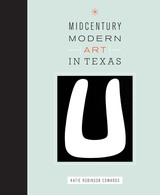 Midcentury Modern Art in Texas
By Katie Robinson Edwards
University of Texas Press, 2014 Winner, Award of Merit for Non-Fiction, The Philosophical Society of Texas, 2015 Before Abstract Expressionism of New York City was canonized as American postwar modernism, the United States was filled with localized manifestations of modern art. One such place where considerable modernist activity occurred was Texas, where artists absorbed and interpreted the latest, most radical formal lessons from Mexico, the East Coast, and Europe, while still responding to the state’s dramatic history and geography. This barely known chapter in the story of American art is the focus of Midcentury Modern Art in Texas. Presenting new research and artwork that has never before been published, Katie Robinson Edwards examines the contributions of many modernist painters and sculptors in Texas, with an emphasis on the era’s most abstract and compelling artists. Edwards looks first at the Dallas Nine and the 1936 Texas Centennial, which offered local artists a chance to take stock of who they were and where they stood within the national artistic setting. She then traces the modernist impulse through various manifestations, including the foundations of early Texas modernism in Houston; early practitioners of abstraction and non-objectivity; the Fort Worth Circle; artists at the University of Texas at Austin; Houston artists in the 1950s; sculpture in and around an influential Fort Worth studio; and, to see how some Texas artists fared on a national scale, the Museum of Modern Art’s “Americans” exhibitions. The first full-length treatment of abstract art in Texas during this vital and canon-defining period, Midcentury Modern Art in Texas gives these artists their due place in American art, while also valuing the quality of Texan-ness that subtly undergirds much of their production.
Mid-Ch’ing Rice Markets and Trade: An Essay in Price History
Han-sheng Chuan and Richard A. Kraus
Harvard University Press, 1975 This analysis of the market sector of the Chinese economy during the middle years of the Ch'ing period is based primarily on price data culled from memorials from government officials to the Ch'ing emperor. A discussion of the nature of inter-provincial rice trade and the transport and financial systems that were developed to support the market sector is preceded by a thorough estimation of the reliability of the Ch'ing price-reporting system. The authors discuss not only how these memorials containing price information were compiled and who was responsible for submitting them to the throne, but whether the prices reported in the memorials were representative of free market prices.
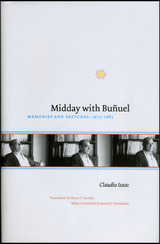 Midday with Buñuel: Memories and Sketches, 1973-1983
Claudio Isaac
Swan Isle Press, 2007 Spanish filmmaker Luis Buñuel (1900–83), known for his surrealist themes and unflinching social criticism, was an artist defined by intellectual ambition and controversy. An exile who produced some of his most famous work in Mexico and France during Franco’s dictatorship, he left a complicated imprint on the creative landscape of the twentieth century and on generations of younger filmmakers—including his Mexican friend Claudio Isaac. Drawn from Isaac’s personal papers, Midday with Buñuel: Memories and Sketches, 1973–1983 is an intimate and unconventional portrait of this cinematic icon—and memoir of Isaac’s own artistic development.
The text includes sketches, vignettes, and anecdotes from Isaac’s notebooks, revealing his perspective first as a precocious boy and then as a young man. Isaac reflects on Buñuel’s presence among a community of exiles, artists, actors, writers, and intellectuals in Mexico City. These are at once touching, perceptive, and critical glimpses into Buñuel’s roles as husband and father, friend and colleague, surrealist, philosopher, and iconoclast during his last years. Throughout, Isaac’s words reveal his deep admiration and affection for an older friend full of contradictions. Intimate photographs from the Isaac family archive complement the writing, and Bryan Thomas Scoular’s careful translation makes this text available for the first time in English.
Part biography, part memoir, Midday with Buñuel brings to life the creative milieu of Mexico City and gives readers a privileged view of the relationship between these two filmmakers.
Middle Age and Aging
Edited by Bernice L. Neugarten
University of Chicago Press, 1968 The process of aging is receiving an increasing amount of attention from behavioral scientists. Middle Age and Aging is an attempt to organize and select from the proliferation of material available in this field. The selections in this volume emphasize some of the major topics that lie closest to the problem of what social and psychological adaptations are required as individuals move through the second half of their lives. Major attention is paid to the importance of age-status and age-sex roles; psychological changes in the life-cycle; social-psychological theories of aging; attitudes toward health; changing family roles; work, retirement, and leisure; certain other dimensions of the immediate social environment such as friendships, neighboring patterns, and living arrangements; differences in cultural settings; and perspectives of time and death.
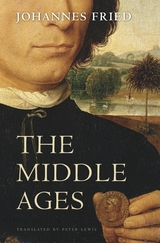 The Middle Ages
Johannes Fried
Harvard University Press, 2015 Since the fifteenth century, when humanist writers began to speak of a “middle” period in history linking their time to the ancient world, the nature of the Middle Ages has been widely debated. Across the millennium from 500 to 1500, distinguished historian Johannes Fried describes a dynamic confluence of political, social, religious, economic, and scientific developments that draws a guiding thread through the era: the growth of a culture of reason.
“Fried’s breadth of knowledge is formidable and his passion for the period admirable…Those with a true passion for the Middle Ages will be thrilled by this ambitious defensio.”
—Dan Jones, Sunday Times
“Reads like a counterblast to the hot air of the liberal-humanist interpreters of European history…[Fried] does justice both to the centrifugal fragmentation of the European region into monarchies, cities, republics, heresies, trade and craft associations, vernacular literatures, and to the persistence of unifying and homogenizing forces: the papacy, the Western Empire, the schools, the friars, the civil lawyers, the bankers, the Crusades…Comprehensive coverage of the whole medieval continent in flux.”
—Eric Christiansen, New York Review of Books
“[An] absorbing book…Fried covers much in the realm of ideas on monarchy, jurisprudence, arts, chivalry and courtly love, millenarianism and papal power, all of it a rewarding read.”
—Sean McGlynn, The Spectator
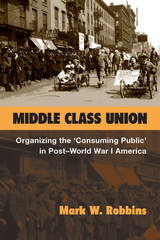 Middle Class Union: Organizing the ‘Consuming Public’ in Post-World War I America
Mark W. Robbins
University of Michigan Press, 2017 Middle Class Union argues that the period following World War I was a pivotal moment in the development of middle-class consumer politics in the 20th century. At this time, middle-class Americans politically mobilized to define for society what was fair in the growing consumer marketplace. They projected themselves as guardians of the producerist values of hard work, honesty, and thrift, and called for greater adherence to them among the working and elite classes. In this era and in later periods, they flexed their muscles as consumers, and claimed to defend the values of the nation.
Combining social history with interdisciplinary approaches to the study of consumption and symbolic space, Middle Class Union illustrates how acts of consumption, representations of the middle class in literary, journalistic, and artistic discourses, and ground-level organizing combined to enable white-collar activists to establish themselves as both the middle class and the backbone of the nation. This book contributes to labor history by examining the nexus of class and consumption to show how many white-collar workers drew on their consumer identity to express an anti-labor politics, later facilitating the struggles of unions throughout the post–World War I years. It also contributes to political history by emphasizing how these middle-class activists laid important groundwork for both 1920s business conservatism and New Deal liberalism. They exerted their political influence well before the post–World War II period, when a self-interested and powerful middle-class consumer identity is more widely acknowledged to have taken hold.
 The Middle East and the Making of the Modern World
Cyrus Schayegh
Harvard University Press, 2017 In The Middle East and the Making of the Modern World, Cyrus Schayegh takes up a fundamental problem historians face: how to make sense of the spatial layeredness of the past. He argues that the modern world’s ultimate socio-spatial feature was not the oft-studied processes of globalization or state formation or urbanization. Rather, it was fast-paced, mutually transformative intertwinements of cities, regions, states, and global circuits, a bundle of processes he calls transpatialization.
To make this case, Schayegh’s study pivots around Greater Syria (Bilad al-Sham in Arabic), which is roughly coextensive with present-day Syria, Jordan, Lebanon, and Israel/Palestine. From this region, Schayegh looks beyond, to imperial and global connections, diaspora communities, and neighboring Egypt, Iraq, and Turkey. And he peers deeply into Bilad al-Sham: at cities and their ties, and at global economic forces, the Ottoman and European empire-states, and the post-Ottoman nation-states at work within the region. He shows how diverse socio-spatial intertwinements unfolded in tandem during a transformative stretch of time, the mid-nineteenth to mid-twentieth centuries, and concludes with a postscript covering the 1940s to 2010s.
Middle East Garden Traditions: Unity and Diversity
Michel Conan
Harvard University Press, 2007 This book unites new information and surprising results from the last fifteen years of garden research, at a remove from the clichés of Orientalism. Garden archaeology reveals the economic importance of Judean gardens in Roman times and the visual complexity of gardens created and transformed in Moorish Spain. More contemporary approaches unravel the cultural continuities, variations, and differences between gardens in the Middle East since Roman times and in the Islamic world. Scholars present new sources for studies of gardens in India, Pakistan, Afghanistan, Iran, the Ottoman world, Judea, Morocco, and Moorish Spain. They explore the interplay of conflicting influences, the cultural reception of gardens in religious and mystical societies, and the political uses of gardens, presenting an unexpected diversity of garden forms in all levels of society.
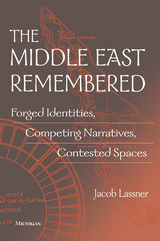 The Middle East Remembered: Forged Identities, Competing Narratives, Contested Spaces
Jacob Lassner
University of Michigan Press, 2000 The Middle East Remembered is the latest work from one of the most productive of Near Eastern historians, Jacob Lassner. The essays and studies that make up this book seek to provide a deep explanation for traditional Muslim and Jewish reactions to events past and present. The volume is in many senses a meditation on the art of history-writing in four crucial eras of the Near East: the founding years of the Muslim community, the generation after the Abbasid overthrow of the early Caliphate, the events leading to collapse of Caliphal governance, and the end of traditional historiographical models on the edge of modernity.
In the first of the book's three parts, Lassner examines what he calls the stratigraphy of the text--he makes sense of the unusual organization of medieval Islamic narrative. The second section investigates issues such as work on city planning and on the creation of imperial centers. The last portion studies the interplay between Jewish and Muslim memory and the trading of themes and ideas between the cultures.
Shorter studies in the volume have been revised, and the author weaves new and complementary essays around them. Earlier work has been transformed and made more available to the general public. The style is accessible, and technical and arcane usages have been kept to a minimum. Throughout there are flashes of the author's wry humor.
Jacob Lassner is Philip M. and Ethel Klutsnick Professor of Jewish Civilization, Northwestern University, and Professor of Middle East History, Tel Aviv University.
 The Middle East under Rome
Maurice Sartre
Harvard University Press, 2004 The ancient Middle East was the theater of passionate interaction between Phoenicians, Aramaeans, Arabs, Jews, Greeks, and Romans. At the crossroads of the Mediterranean, Mesopotamia, and the Arabian peninsula, the area dominated by what the Romans called Syria was at times a scene of violent confrontation, but more often one of peaceful interaction, of prosperous cultivation, energetic production, and commerce--a crucible of cultural, religious, and artistic innovations that profoundly determined the course of world history.
Maurice Sartre has written a long overdue and comprehensive history of the Semitic Near East (modern Syria, Lebanon, Jordan, and Israel) from the eve of the Roman conquest to the end of the third century C.E. and the dramatic rise of Christianity. Sartre's broad yet finely detailed perspective takes in all aspects of this history, not just the political and military, but economic, social, cultural, and religious developments as well. He devotes particular attention to the history of the Jewish people, placing it within that of the whole Middle East.
Drawing upon the full range of ancient sources, including literary texts, Greek, Latin, and Semitic inscriptions, and the most recent archaeological discoveries, The Middle East under Rome will be an indispensable resource for students and scholars. This absorbing account of intense cultural interaction will also engage anyone interested in the history of the Middle East.
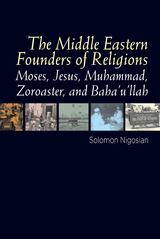 The Middle Eastern Founders of Religion: Moses, Jesus, Muhammad, Zoroaster and Baha'u'llah
Solomon Nigosian
Sussex Academic Press, 2022 This book presents an academic introduction to the life and teachings of five Middle Eastern founders of religion -- five individuals whose systems of faith, thought, and action have won the allegiance of millions. All believed to have experienced a personal encounter with the divine -- a "voice" directly from the "beyond" -- to proclaim God's message to the community or people to which they belonged. All attracted followers and opponents. Similarities in their religious outlook abound; but differences between the five pervade their approach toward society and culture, with issues of law, war, women, morality, ethics, the kingdom of God, life after death, and eternal judgment distinguishing their respective beliefs. An Introduction provides an overview of the political history of the Middle East based on four periods (Early, Persian, Hellenistic, and Roman) and a brief description of the surviving religious traditions of the Middle East (including a proposal regarding the nature of so-called "selected" individuals). Five chapter texts separately address each religious founder from the viewpoint of readers from the Judaic and Christian traditions in terms of the religious world into which each individual appeared; the traditional account as presented by available sources or evidences; the reliability of the available sources or evidences for reconstructing their biographies; and a critical assessment of both the sources or evidences and the traditional account. A concluding chapter compares the similarities and differences of the received divine messages, and notes that no new message has ever succeeded in shaking off entirely the influence of the faith from which it arose. The work has been specifically designed for student adoption in Religious Studies.
Middle English Dictionary: A.1
Robert E. Lewis, Editor-in-Chief
University of Michigan Press, 1956 The most important modern reference work for Middle English studies
Middle English Dictionary: A.2
Robert E. Lewis, Editor-in-Chief
University of Michigan Press, 1956 The most important modern reference work for Middle English studies
Middle English Dictionary: A.3
Robert E. Lewis, Editor-in-Chief
University of Michigan Press, 1956 The most important modern reference work for Middle English studies
Middle English Dictionary: A.4
Robert E. Lewis, Editor-in-Chief
University of Michigan Press, 1957 The most important modern reference work for Middle English studies
Middle English Dictionary: B.1
Robert E. Lewis, Editor-in-Chief
University of Michigan Press, 1957 The most important modern reference work for Middle English studies
Middle English Dictionary: B.2
Robert E. Lewis, Editor-in-Chief
University of Michigan Press, 1957 The most important modern reference work for Middle English studies
Middle English Dictionary: B.3
Robert E. Lewis, Editor-in-Chief
University of Michigan Press, 1957 The most important modern reference work for Middle English studies
Middle English Dictionary: B.4
Robert E. Lewis, Editor-in-Chief
University of Michigan Press, 1958 The most important modern reference work for Middle English studies
Middle English Dictionary: B.5
Robert E. Lewis, Editor-in-Chief
University of Michigan Press, 1958 The most important modern reference work for Middle English studies
Middle English Dictionary: C.1
Robert E. Lewis, Editor-in-Chief
University of Michigan Press, 1959 The most important modern reference work for Middle English studies
Middle English Dictionary: C.2
Robert E. Lewis, Editor-in-Chief
University of Michigan Press, 1959 The most important modern reference work for Middle English studies
Middle English Dictionary: C.3
Robert E. Lewis, Editor-in-Chief
University of Michigan Press, 1959 The most important modern reference work for Middle English studies
Middle English Dictionary: C.4
Robert E. Lewis, Editor-in-Chief
University of Michigan Press, 1960 The most important modern reference work for Middle English studies
Middle English Dictionary: C.5
Robert E. Lewis, Editor-in-Chief
University of Michigan Press, 1960 The most important modern reference work for Middle English studies
Middle English Dictionary: C.6
Robert E. Lewis, Editor-in-Chief
University of Michigan Press, 1960 The most important modern reference work for Middle English studies
Middle English Dictionary: D.1
Robert E. Lewis, Editor-in-Chief
University of Michigan Press, 1961 The most important modern reference work for Middle English studies
Middle English Dictionary: D.2
Robert E. Lewis, Editor-in-Chief
University of Michigan Press, 1961 The most important modern reference work for Middle English studies
Middle English Dictionary: D.3
Robert E. Lewis, Editor-in-Chief
University of Michigan Press, 1961 The most important modern reference work for Middle English studies
Middle English Dictionary: D.4
Robert E. Lewis, Editor-in-Chief
University of Michigan Press, 1962 The most important modern reference work for Middle English studies
Middle English Dictionary: D.5
Robert E. Lewis, Editor-in-Chief
University of Michigan Press, 1962 The most important modern reference work for Middle English studies
Middle English Dictionary: E.1
Robert E. Lewis, Editor-in-Chief
University of Michigan Press, 1952 The most important modern reference work for Middle English studies
Middle English Dictionary: E.2
Robert E. Lewis, Editor-in-Chief
University of Michigan Press, 1953 The most important modern reference work for Middle English studies
Middle English Dictionary: E.3
Robert E. Lewis, Editor-in-Chief
University of Michigan Press, 1953 The most important modern reference work for Middle English studies
Middle English Dictionary: F.1
Robert E. Lewis, Editor-in-Chief
University of Michigan Press, 1953 The most important modern reference work for Middle English studies
Middle English Dictionary: F.2
Robert E. Lewis, Editor-in-Chief
University of Michigan Press, 1954 The most important modern reference work for Middle English studies
Middle English Dictionary: F.3
Robert E. Lewis, Editor-in-Chief
University of Michigan Press, 1954 The most important modern reference work for Middle English studies
Middle English Dictionary: F.4
Robert E. Lewis, Editor-in-Chief
University of Michigan Press, 1954 The most important modern reference work for Middle English studies
Middle English Dictionary: G.1
Robert E. Lewis, Editor-in-Chief
University of Michigan Press, 1963 The most important modern reference work for Middle English studies
Middle English Dictionary: G.2
Robert E. Lewis, Editor-in-Chief
University of Michigan Press, 1963 The most important modern reference work for Middle English studies
Middle English Dictionary: G.3
Robert E. Lewis, Editor-in-Chief
University of Michigan Press, 1964 The most important modern reference work for Middle English studies
Middle English Dictionary: H.1
Robert E. Lewis, Editor-in-Chief
University of Michigan Press, 1966 The most important modern reference work for Middle English studies
Middle English Dictionary: H.2
Robert E. Lewis, Editor-in-Chief
University of Michigan Press, 1966 The most important modern reference work for Middle English studies
Middle English Dictionary: H.3
Robert E. Lewis, Editor-in-Chief
University of Michigan Press, 1966 The most important modern reference work for Middle English studies
Middle English Dictionary: H.4
Robert E. Lewis, Editor-in-Chief
University of Michigan Press, 1966 The most important modern reference work for Middle English studies
Middle English Dictionary: H.5
Robert E. Lewis, Editor-in-Chief
University of Michigan Press, 1967 The most important modern reference work for Middle English studies
Middle English Dictionary: I.1
Robert E. Lewis, Editor-in-Chief
University of Michigan Press, 1968 The most important modern reference work for Middle English studies
Middle English Dictionary: I.2
Robert E. Lewis, Editor-in-Chief
University of Michigan Press, 1968 The most important modern reference work for Middle English studies
Middle English Dictionary: J.1
Robert E. Lewis, Editor-in-Chief
University of Michigan Press, 1969 The most important modern reference work for Middle English studies
Middle English Dictionary: K.1
Robert E. Lewis, Editor-in-Chief
University of Michigan Press, 1969 The most important modern reference work for Middle English studies
Middle English Dictionary: L.1
Robert E. Lewis, Editor-in-Chief
University of Michigan Press, 1970 The most important modern reference work for Middle English studies
Middle English Dictionary: L.2
Robert E. Lewis, Editor-in-Chief
University of Michigan Press, 1970 The most important modern reference work for Middle English studies
Middle English Dictionary: L.3
Robert E. Lewis, Editor-in-Chief
University of Michigan Press, 1971 The most important modern reference work for Middle English studies
Middle English Dictionary: L.4
Robert E. Lewis, Editor-in-Chief
University of Michigan Press, 1972 The most important modern reference work for Middle English studies
Middle English Dictionary: L.5
Robert E. Lewis, Editor-in-Chief
University of Michigan Press, 1973 The most important modern reference work for Middle English studies
Middle English Dictionary: L.6
Robert E. Lewis, Editor-in-Chief
University of Michigan Press, 1973 The most important modern reference work for Middle English studies
Middle English Dictionary: M.1
Robert E. Lewis, Editor-in-Chief
University of Michigan Press, 1975 The most important modern reference work for Middle English studies
Middle English Dictionary: M.2
Robert E. Lewis, Editor-in-Chief
University of Michigan Press, 1975 The most important modern reference work for Middle English studies
Middle English Dictionary: M.3
Robert E. Lewis, Editor-in-Chief
University of Michigan Press, 1975 The most important modern reference work for Middle English studies
Middle English Dictionary: M.4
Robert E. Lewis, Editor-in-Chief
University of Michigan Press, 1977 The most important modern reference work for Middle English studies
Middle English Dictionary: M.5
Robert E. Lewis, Editor-in-Chief
University of Michigan Press, 1977 The most important modern reference work for Middle English studies
Middle English Dictionary: M.6
Robert E. Lewis, Editor-in-Chief
University of Michigan Press, 1978 The most important modern reference work for Middle English studies
Middle English Dictionary: N.1
Robert E. Lewis, Editor-in-Chief
University of Michigan Press, 1978 The most important modern reference work for Middle English studies
Middle English Dictionary: N.2
Robert E. Lewis, Editor-in-Chief
University of Michigan Press, 1979 The most important modern reference work for Middle English studies
Middle English Dictionary: N.3
Robert E. Lewis, Editor-in-Chief
University of Michigan Press, 1979 The most important modern reference work for Middle English studies
Middle English Dictionary: O.1
Robert E. Lewis, Editor-in-Chief
University of Michigan Press, 1980 The most important modern reference work for Middle English studies
Middle English Dictionary: O.2
Robert E. Lewis, Editor-in-Chief
University of Michigan Press, 1980 The most important modern reference work for Middle English studies
Middle English Dictionary: O.3
Robert E. Lewis, Editor-in-Chief
University of Michigan Press, 1981 The most important modern reference work for Middle English studies
Middle English Dictionary: O.4
Robert E. Lewis, Editor-in-Chief
University of Michigan Press, 1981 The most important modern reference work for Middle English studies
Middle English Dictionary: P.1
Robert E. Lewis, Editor-in-Chief
University of Michigan Press, 1982 The most important modern reference work for Middle English studies
Middle English Dictionary: P.2
Robert E. Lewis, Editor-in-Chief
University of Michigan Press, 1982 The most important modern reference work for Middle English studies
Middle English Dictionary: P.3
Robert E. Lewis, Editor-in-Chief
University of Michigan Press, 1982 The most important modern reference work for Middle English studies
Middle English Dictionary: P.4
Robert E. Lewis, Editor-in-Chief
University of Michigan Press, 1983 The most important modern reference work for Middle English studies
Middle English Dictionary: P.5
Robert E. Lewis, Editor-in-Chief
University of Michigan Press, 1983 The most important modern reference work for Middle English studies
Middle English Dictionary: P.6
Robert E. Lewis, Editor-in-Chief
University of Michigan Press, 1983 The most important modern reference work for Middle English studies
Middle English Dictionary: P.7
Robert E. Lewis, Editor-in-Chief
University of Michigan Press, 1983 The most important modern reference work for Middle English studies
Middle English Dictionary: P.8
Robert E. Lewis, Editor-in-Chief
University of Michigan Press, 1984 The most important modern reference work for Middle English studies
Middle English Dictionary: Q.1
Robert E. Lewis, Editor-in-Chief
University of Michigan Press, 1985 The most important modern reference work for Middle English studies
Middle English Dictionary: R.1
Robert E. Lewis, Editor-in-Chief
University of Michigan Press, 1985 The most important modern reference work for Middle English studies
Middle English Dictionary: R.2
Robert E. Lewis, Editor-in-Chief
University of Michigan Press, 1985 The most important modern reference work for Middle English studies
Middle English Dictionary: R.3
Robert E. Lewis, Editor-in-Chief
University of Michigan Press, 1985 The most important modern reference work for Middle English studies
Middle English Dictionary: R.4
Robert E. Lewis, Editor-in-Chief
University of Michigan Press, 1985 The most important modern reference work for Middle English studies
Middle English Dictionary: R.5
Robert E. Lewis, Editor-in-Chief
University of Michigan Press, 1986 The most important modern reference work for Middle English studies
Middle English Dictionary: R.6
Robert E. Lewis, Editor-in-Chief
University of Michigan Press, 1986 The most important modern reference work for Middle English studies
Middle English Dictionary: S.1
Robert E. Lewis, Editor-in-Chief
University of Michigan Press, 1986 The most important modern reference work for Middle English studies
Middle English Dictionary: S.10
Robert E. Lewis, Editor-in-Chief
University of Michigan Press, 1989 The most important modern reference work for Middle English studies
Middle English Dictionary: S.11
Robert E. Lewis, Editor-in-Chief
University of Michigan Press, 1989 The most important modern reference work for Middle English studies
Middle English Dictionary: S.12
Robert E. Lewis, Editor-in-Chief
University of Michigan Press, 1990 The most important modern reference work for Middle English studies
Middle English Dictionary: S.13
Robert E. Lewis, Editor-in-Chief
University of Michigan Press, 1990 The most important modern reference work for Middle English studies
Middle English Dictionary: S.14
Robert E. Lewis, Editor-in-Chief
University of Michigan Press, 1990 The most important modern reference work for Middle English studies
Middle English Dictionary: S.15
Robert E. Lewis, Editor-in-Chief
University of Michigan Press, 1991 The most important modern reference work for Middle English studies
Middle English Dictionary: S.16
Robert E. Lewis, Editor-in-Chief
University of Michigan Press, 1991 The most important modern reference work for Middle English studies
Middle English Dictionary: S.17
Robert E. Lewis, Editor-in-Chief
University of Michigan Press, 1992 The most important modern reference work for Middle English studies
Middle English Dictionary: S.18
Robert E. Lewis, Editor-in-Chief
University of Michigan Press, 1992 The most important modern reference work for Middle English studies
Middle English Dictionary: S.2
Robert E. Lewis, Editor-in-Chief
University of Michigan Press, 1986 The most important modern reference work for Middle English studies
Middle English Dictionary: S.3
Robert E. Lewis, Editor-in-Chief
University of Michigan Press, 1987 The most important modern reference work for Middle English studies
Middle English Dictionary: S.4
Robert E. Lewis, Editor-in-Chief
University of Michigan Press, 1987 The most important modern reference work for Middle English studies
Middle English Dictionary: S.5
Robert E. Lewis, Editor-in-Chief
University of Michigan Press, 1987 The most important modern reference work for Middle English studies
Middle English Dictionary: S.6
Robert E. Lewis, Editor-in-Chief
University of Michigan Press, 1988 The most important modern reference work for Middle English studies
Middle English Dictionary: S.7
Robert E. Lewis, Editor-in-Chief
University of Michigan Press, 1988 The most important modern reference work for Middle English studies
Middle English Dictionary: S.8
Robert E. Lewis, Editor-in-Chief
University of Michigan Press, 1988 The most important modern reference work for Middle English studies
Middle English Dictionary: S.9
Robert E. Lewis, Editor-in-Chief
University of Michigan Press, 1988 The most important modern reference work for Middle English studies
Middle English Dictionary: T.1
Robert E. Lewis, Editor-in-Chief
University of Michigan Press, 1993 The most important modern reference work for Middle English studies
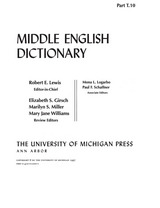 Middle English Dictionary: T.10
Robert E. Lewis, Editor-in-Chief
University of Michigan Press, 1997 The goal of the Middle English Dictionary is to include all meanings, grammatical forms, and spellings of all the words identified by its extensive reading program. When completed, it will represent what has been called the greatest achievement in medieval scholarship in America and the most important single project in English historical lexicography being carried out anywhere today. After sixty-five years it will have produced about 15,000 pages.
The Middle English Dictionary is a monumental scholarly endeavor that began more than fifty years ago and is expected to be completed in the late-1990s. The task of the editors compiling the dictionary is to document the English language from just after the Norman Conquest up to the introduction of the printing press at the end of the 1400s. With that innovation the language became more or less standardized, but during the Middle Ages the language was evolving under the stress of events and social change, particularly as French culture was absorbed into the language. These were truly the formative years of the English language, and they present major challenges to lexicographers.
Published volumes include all fascicles from A.1 through T.10, plus the Plan and Bibliography.
Middle English Dictionary: T.2
Robert E. Lewis, Editor-in-Chief
University of Michigan Press, 1993 The most important modern reference work for Middle English studies
Middle English Dictionary: T.3
Robert E. Lewis, Editor-in-Chief
University of Michigan Press, 1994 The most important modern reference work for Middle English studies
Middle English Dictionary: T.4
Robert E. Lewis, Editor-in-Chief
University of Michigan Press, 1994 The most important modern reference work for Middle English studies
Middle English Dictionary: T.5
Robert E. Lewis, Editor-in-Chief
University of Michigan Press, 1995 The most important modern reference work for Middle English studies
Middle English Dictionary: T.6
Robert E. Lewis, Editor-in-Chief
University of Michigan Press, 1995 The most important modern reference work for Middle English studies
|
|